On the final day of our lab experience in Jordan, participants, C-Hub + IDare staff, and I tromped up cascading waterfalls in Wadi Mujib. It was our final experience together - a capstone in embodied research, and most memorably, a really fun field trip. Wadi Mujib is a canyon with a river flowing through it that empties out into the Dead Sea. The water is sacred, and the site has been developed into a well-run tourist operation, yet one still feels wild exploring the twists and turns of the canyon and the crystal blue-green water that flows down over red rocks.

For many of the participants on our trip, it was the first time they had experienced this sort of outdoor adventure. It was my first time at Wadi Mujib as well, making it novel for us all. There are moments during the kilometers-long ascent up to the waterfall that are peaceful; you can float, belly up, gazing at the towering red rocks above you, reflections of the water shimmering like a mirage.

There are also moments that are treacherous; fighting your way up the crashing weight of a waterfall over slippery rocks when a strange hand appears from above, pulling you over the ledge. You climb up, exasperated. In the end, all thirteen of us made it all the way up to the waterfall and back down. It was wild, but invigorating.
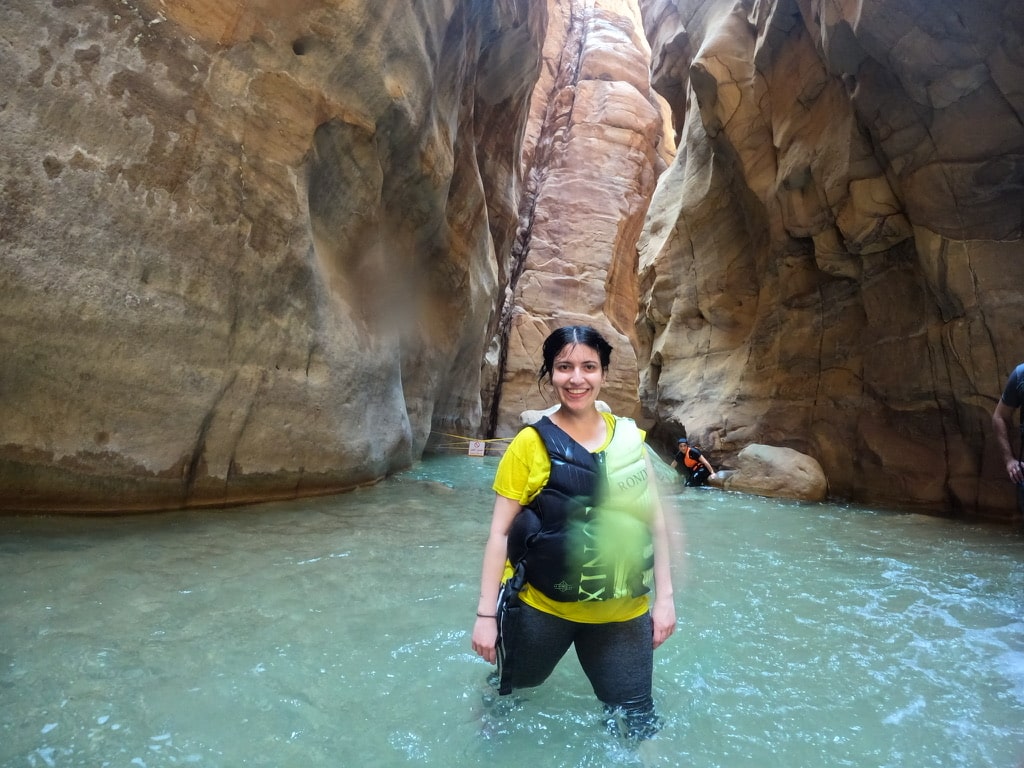

This might be a great way to describe the entire experience of Creative Impact Lab Amman: wild yet invigorating. Our workshop was full of research: we visited Darat al Funun, a contemporary art center in Amman, to see the exhibition Re-rooting. This exhibition was certainly wild, with live plant works, installations including jars of water, and tumbling orange crates.
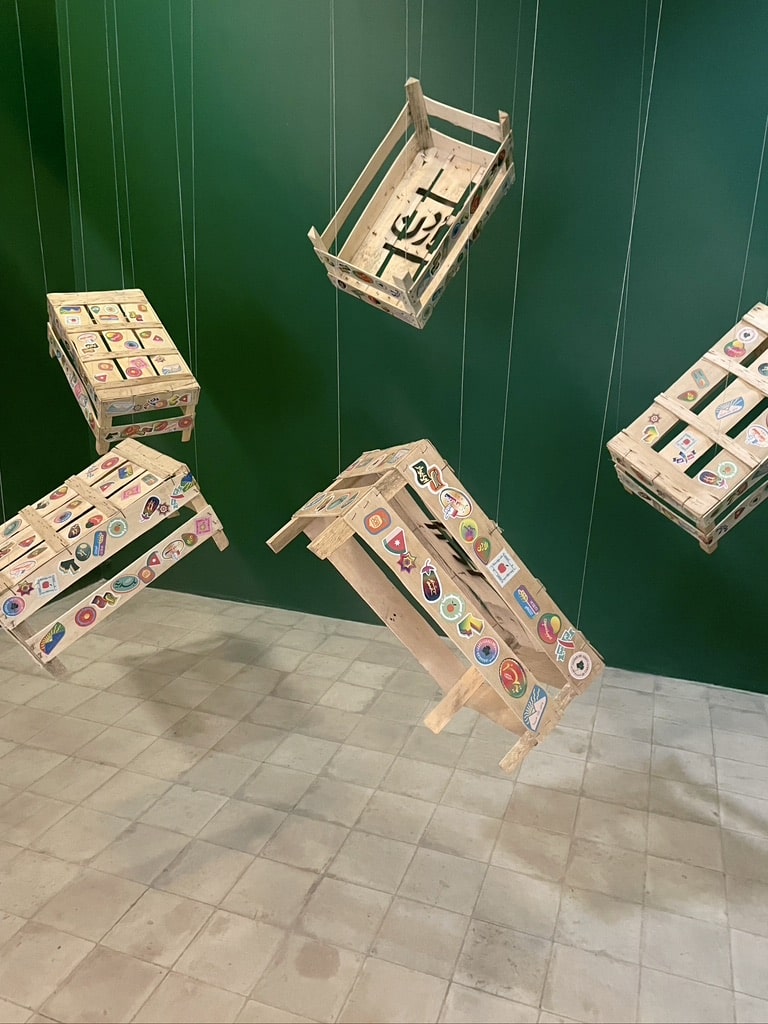
The exhibition was poignant and central to our research on water sustainability in Jordan. In Re-rooting “the constellation of works presented attempts to untangle the complex histories that make up the current crisis of economy and ecology, not only in an effort to denunciate them but also to showcase hacks, diversions, and solutions. They look at forms of self-determination and autonomy performed by local communities as a rejection of normalized exploitative and colonial models.” This exhibition became central in our thinking around the issues present in the region that relate to water sustainability: it is all rooted in the land, in autonomy over the land, and agency in one’s own future.

Our learnings from an activity with CEWAS Middle East were equally as inspiring for participant projects. Aline Bussman led us through a workshop on the water system in Jordan. We were able to understand the complex web of inputs and outputs, and the lens of cultural + social perspectives of water, that make sustainability so challenging. It is not neat, it is not straightforward. The aquifers that supply Jordan with water are being emptied, and unlike surface water, aquifers cannot be refilled. Leaky transportation pipes and public perceptions against recycled water all present challenges to creating more sustainable processes for water consumption in the area.
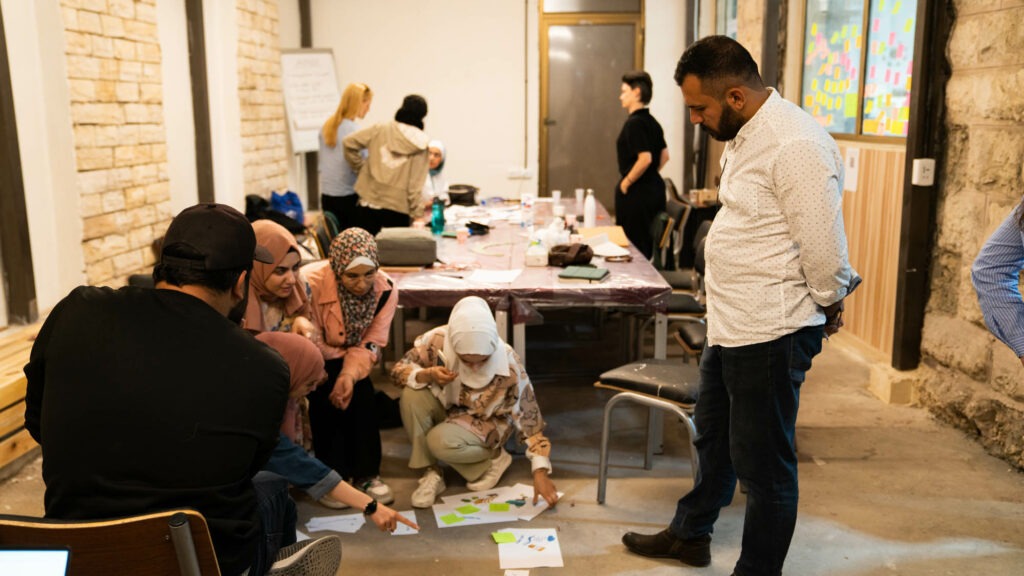
Through their projects, participants turned their inspirations into projection mapping + sculptural artworks using video, sound, and sculpture. The projects reflected metaphorically on our condition in relation to water: Nasser + Abdullah’s project ‘Love Drops’ likening the human race to a fish out of water, flopping in panic. They also ruminated on our intrinsic linkages: Seem and Sanya’s Fishbowl, and Salam and Maha’s Sea Waves Speak reflect on the ways in which humans and fish are tied in our wellbeing. Afnan’s SoS considers the relationships between the human body and health, and the environmental body and health. Some even took more direct inspiration from Re-Rooting: Hiba’s project The Orange Tree comments personally on the Palestinian struggle to reclaim the Jaffa tree production, using the symbolic orange and home-grown orange plants as a moment of personal activism.


Maryam and Raghad’s project Valley of Color reflects on pollution and the impact it has on the integrity of revered water sources like Wadi Mujib. Nawal’s animation visualizes the errors in water transportation and leaky infrastructure.
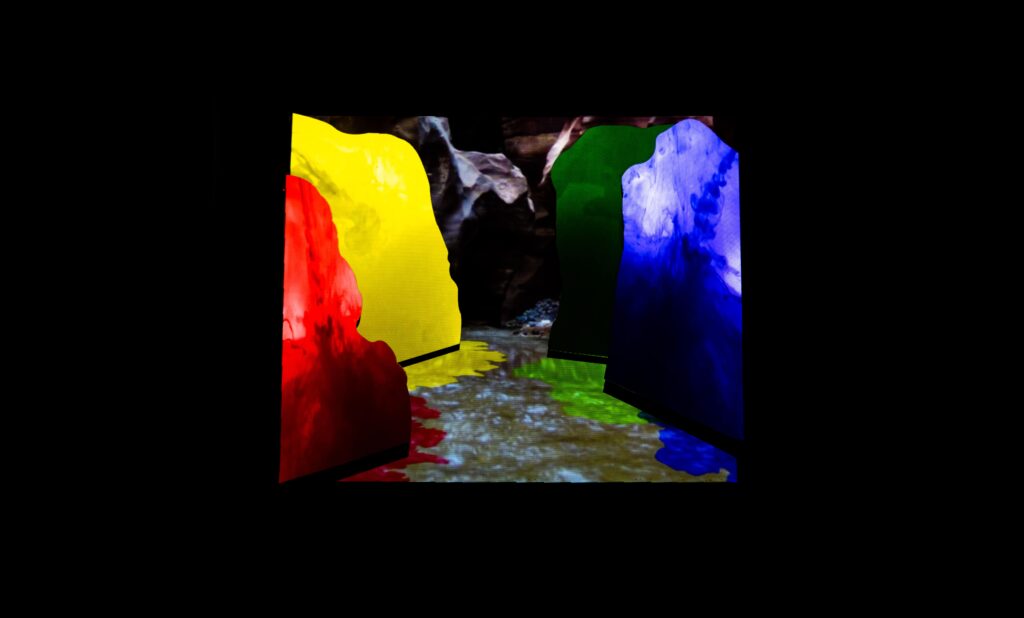
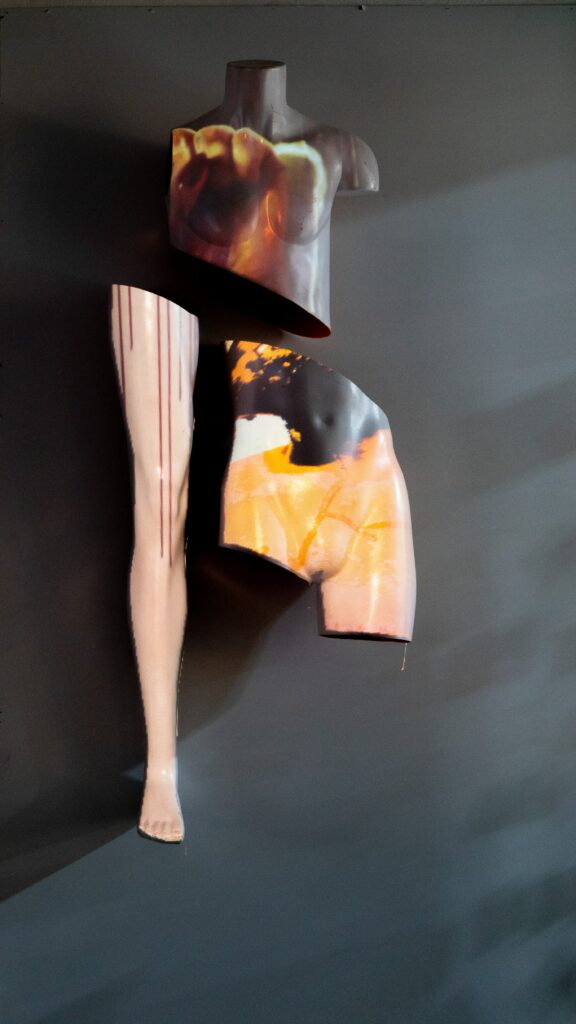
The constellation of works is moving. It is forward thinking, yet also reflective on regional traditions and the unique history of the many people who call Jordan home. Creating these works, like our ascent up the Wadi Mujib, was wild. We encountered many technical challenges, and learned quite a few skills in a short period of time. At times, the language barrier was frustrating, but we found ways to communicate when translation was challenging.
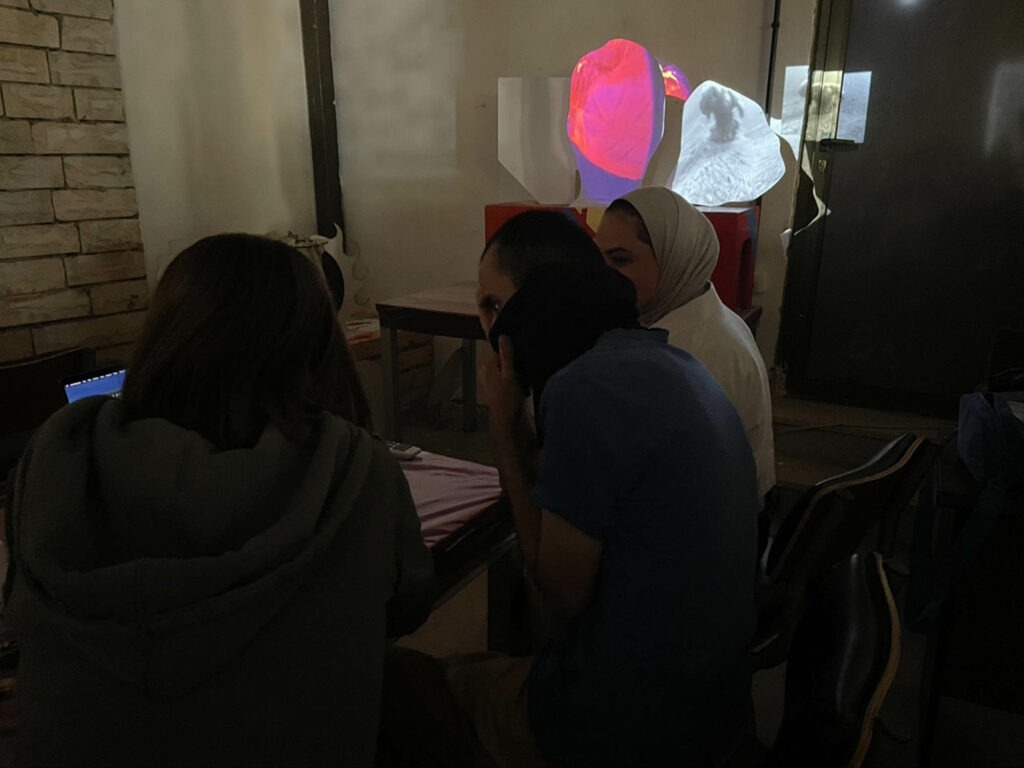
Participants learned from each other, assisting one another with projection mapping, ideas for fabrication of their final projects, and hanging the exhibition. This sort of exchange makes learning together rich; when students become teachers, and the typical hierarchy of knowledge production shifts. We all learned from one another, through skill sharing, story telling, and creative production. We all helped each other climb up and over the waterfall.
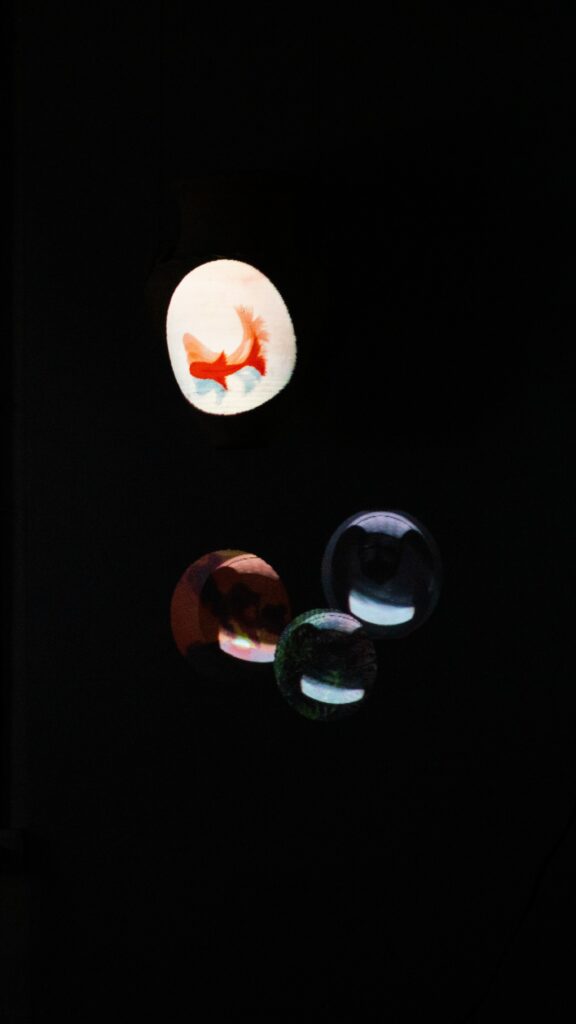
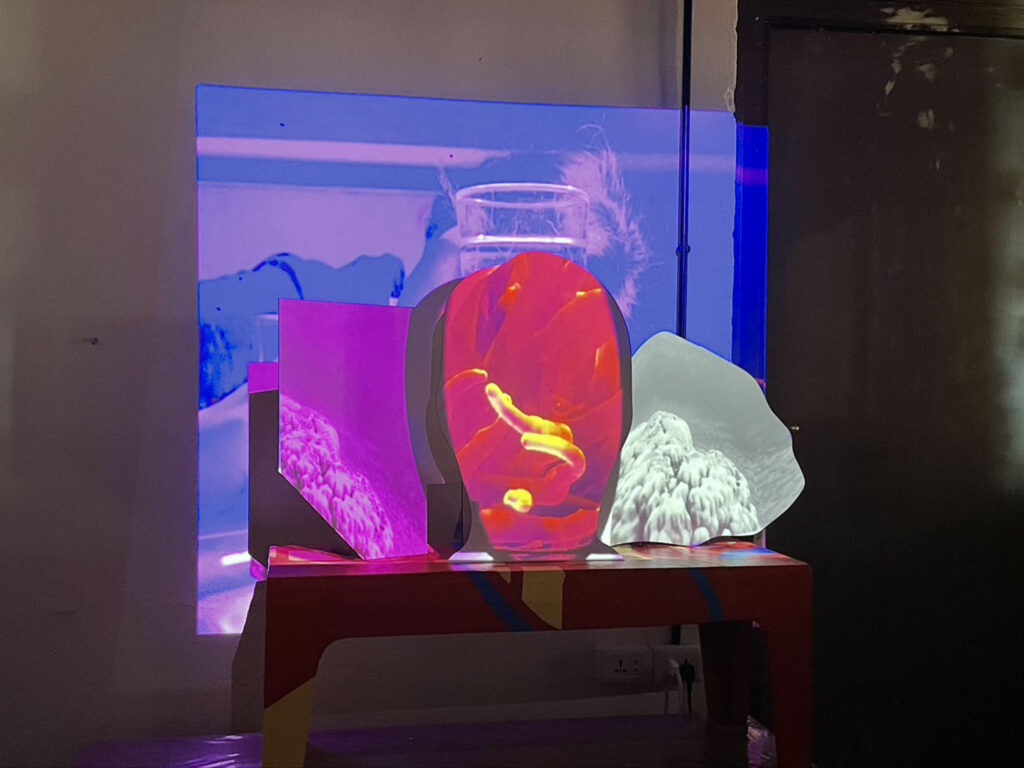
The spirit of our cohort and team at IDare and C-Hub allowed us to push forward through this wild process of collaborative creative production, and in the end create something invigorating. The projects were all exhibited together for the public and virtual guests. What is hidden behind them, is the strong bonds we all formed in moving through process: in learning together, in having new experiences together, in our meals and Google Translate conversations, and quiet moments looking at art.
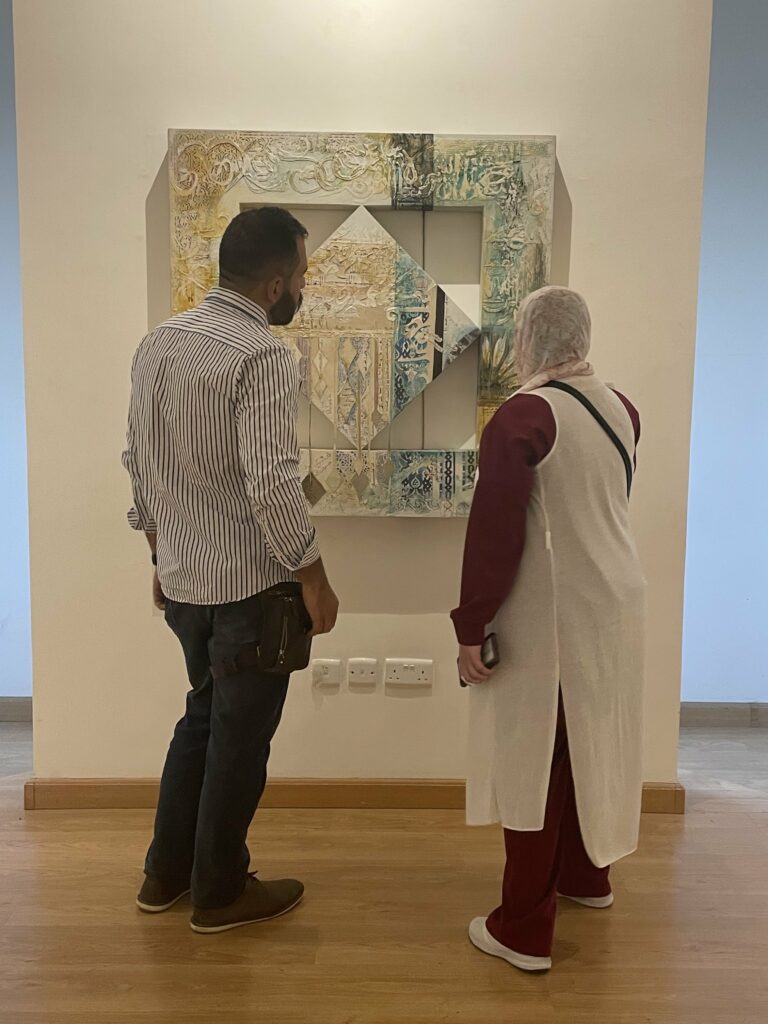
The participants presented their projects during an in-person final event at the C-Hub in Amman, Jordan. Shamsher Virk (ZERO1), SaraNoa Mark (guest artist + critic) and I joined in remotely. It was disheartening to experience the projects only virtually, but even at a distance, the pride both participants and our team at C-Hub took in the presentation of these ambitious works was palpable. The works are installed in a classroom modified to become a temporary gallery at the C-Hub, and project presentations took place in the makerspace adjacent to the artworks.

Participants shared the concepts, materials, and process of their pieces, as well as future plans for expanding upon these ideas or their creative practice.



Guests to the C-Hub were able to share in this final and critical step of the artist's journey: public presentation. It is clear that the ideas and experiences we had together will live on, and many participants have been planning ways to continue and expand upon their projects. Hiba hopes to host her work in conjunction with a local symphony, Seem and Sanya hope to apply to an art exhibition with the piece. Raghad hopes to make a new work considering concepts around water sustainability. It is my personal hope that the collaborative relationships borne of this exchange will also live on, and that this was the beginning of something wild and invigorating, rather than a predictable end. The spirit of this exchange is what we can hope for in the face of global climate resilience: determination, follow-through, and invigorating collaboration.
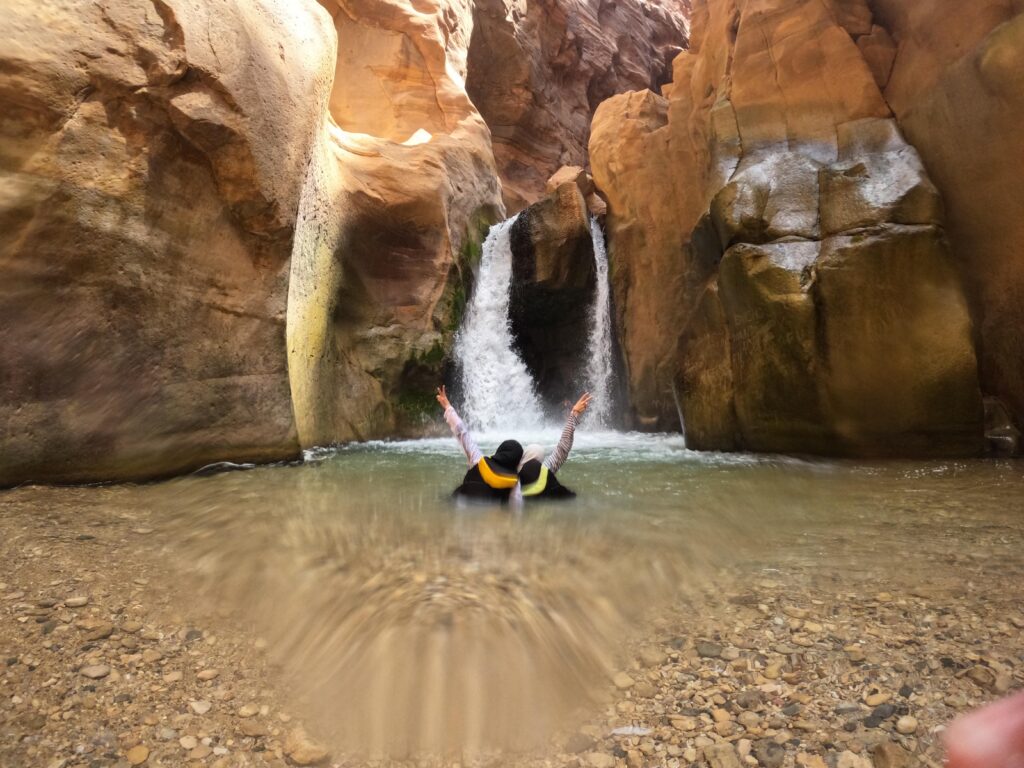
Feature image credit: Fishbowl, Sanya Qumuq and Seem Alsayeh. Photograph by Mohammad Saradeeh.
From researching underwater adventures in the Red Sea, to learning about the historic sites in the Wadi Rum, the research and preparation phase of the Creative Impact Lab Amman has been exciting and enlightening. The topic for the Lab is sustainability, and given my own recent work on ocean health, I feel compelled to explore water as a cultural and ecological resource in Jordan. Like parts of California (where I currently live), Jordan is stressed for water, while facing additional challenges from the climate crisis and population growth. Aquifers that supply Jordanians with clean water are running dry, impacting both the daily available water for urban dwellers, and the ability for agriculturalists in rural areas to maintain sustainable livelihoods.
I want to raise this as a topic of discussion with the workshop participants and learn about their own relationships to water. How do they feel about the climate crisis in Jordan? In what ways does water show up in their lives — in cultural and historic art and references, in pop culture, in their daily conversations with friends and family? How do they envision the future of water? We will explore these questions through a two-week intensive hosted by IDare for Sustainable Development in the capital city, Amman.

Water is both a collective and highly personal resource, so I want our multimedia project to explore methods of collective resilience and collaboration. In my past work facilitating collaborative groups with Mountain Time Arts in Bozeman, Montana, and in my home city of Los Angeles, I have found that the challenges of collaboration bring huge rewards. I hope that as a team we can all learn to work together and generate new ideas and dialogues through the process of co-creating — a skill set that is essential for climate adaptation.

In reviewing the applications for the Lab, I am excited to see how many participants are passionate about sustainability and water issues in Jordan, while also being excited to incorporate art and technology for creating responses to ecological issues. Our team will include architects, designers, teachers, artists, water experts and more. My hope is that we will all learn from one another, and our collective installation will emerge from the structures of collaboration.

For our collaborative project, we will develop a multimedia installation using sculpture, video, sound, and projection mapping. We will weave influences into the work that are pulled from local art galleries and museums, as well as the participants' own cultural inspirations, research and knowledge. This exchange of ideas, skills, time, meals, and creative production becomes a meaningful part of the process of making. While some of the details regarding the final form of the multimedia installation are to be determined, I am excited to continue creating a structure for our collaboration.

Feature image credit: The Aquarium at Heidi Duckler Dance, 2022. Photo by Rush Varela.
Landing a role at ZERO1 almost five years ago to help manage American Arts Incubator, our flagship creative exchange program at the time, was my entry point into working in the arts.
I’d always held a deep appreciation for the value of cultural exchange, having been raised in a binational and bilingual household, majoring in Hispanic Studies during my undergraduate studies, and spending close to a year working at an educational institution in Bangalore in my early 20s.
However, the learning curve from engaging in cultural exchange to being the bearer and molder of this kind of container, while simultaneously deepening my understanding of the media arts field, was a steep one. I’m glad I was able to do so within an organizational culture like ZERO1’s, which focuses deeply on process and encourages taking a critical approach to the tools we use in our work.

I've grappled with many interesting and challenging questions over the last several years: How does one surface and mitigate power dynamics in the context of exchange? How does one approach sensitive social issues in a variety of cultural contexts? What can be bridged through co-creative art making as a vehicle versus another medium, like language? (Also, how does one get an artist to hand in their deliverables on time?).
I’m grateful to have been able to work in collaboration with many artists who also engage with complex questions themselves through their practice, and for being able to craft spaces for them to be in dialogue with each other. I have always been passionate about creating containers and facilitating experiences for others to grow and connect, both personally and professionally.
One of the objectives of our exchange programs is to build mutual understanding between creative communities around the world. To prepare for and contextualize each exchange we facilitate, I’ve delved deeper into a wide variety of topics from the effects of pollution in Alexandria, Egypt to the Maidan Revolution in Ukraine to the Brumadinho Dam Disaster in Minas Gerais, Brazil. On the research trips I’ve made to these locations, after visiting historical sites and conversing with affected communities, I am reminded time and again of the shift from an intellectual understanding to a relational, lived understanding of an issue, rooted in place.
In a time of increased political polarization and isolation due to the pandemic, I feel that exchange through person-to-person connection has taken on an increased urgency. Personally, I have found that the experiences I’ve mentioned above have allowed me to more gracefully toggle between interpersonal relating and awareness of one’s position in larger socioeconomic and political systems while engaging with difficult topics. I often think of Glenn Harris’ words during Race Forward’s annual conference in 2020, “We need to be hard on systems and soft on each other.”

In addition, when thinking about community-engaged artists as civic leaders, I’m reminded of Cristobal Martinez’s conceptualization of “artists as ears” — listening deeply before synthesizing, creating, and amplifying. I’ve also seen this style of leadership modeled by my colleague, Shamsher Virk, whom I’ve had the pleasure of working with for my entire tenure at ZERO1. As ZERO1 has evolved over the past five years, he has deftly led the strategic charge. He is a skillful facilitator, inclusive community-builder, and arts administrator extraordinaire; I’ve deeply enjoyed our professional partnership.
Working with a transdisciplinary approach in the arts has allowed me to take a step back and critically re-examine my beliefs about knowledge production in a way that has been liberating — opening up avenues to new ways of understanding myself and the world around us.
This job also opened the door for me to explore and better understand the Bay Area arts scene, which has been a life-enriching opportunity that has exposed me to new experiences, perspectives, and ways of living and being that I could not have imagined when I first arrived in San Francisco.
The War in Ukraine
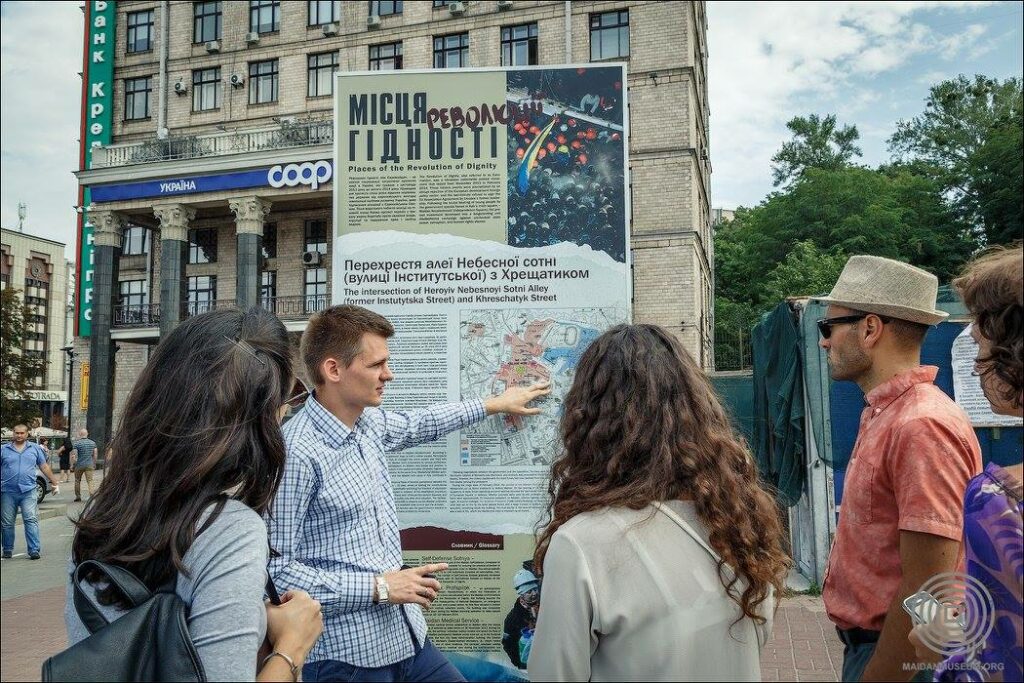
I would be remiss if I didn’t touch on the current situation in Ukraine in this post. Over the course of my time at ZERO1, I’ve had the opportunity to visit the country twice for our creative exchange programming. My first work trip for American Arts Incubator was to Kyiv in 2017, with a subsequent trip in the fall of 2019. I had the opportunity to work closely with the fantastic staff at IZOLYATSIA, an arts organization that had experienced internal displacement in Ukraine from their site in Donetsk in 2014. I visited many galleries, museums, and cultural sites, as well as engaged in conversations with artists, curators, and other knowledge- and culture-bearers within the creatively prolific country.
One reason I am passionate about exchange is that it challenges the myth of the Other. It is a continuous, visceral reminder that people are people everywhere — deserving of peace and basic human rights. It collapses the distance between here and “elsewhere” when tragedies and war happen. Olia, who participated in our 2020 virtual exchange, is sheltering from missiles in a bunker in Kharkhiv, and many of the artists who participated in our programming remain in Kyiv, which has been withstanding Russian attacks since February 25.
As a parting call, I ask that you support fellow artists, curators and cultural workers of Ukraine through the Ukrainian Emergency Art Fund and by getting further informed on the war in Ukraine.
What’s Next?
After my departure from ZERO1, I will be spending some time with my family in Japan. I hope to take some time to switch modes from “doing” to “being,” and see what might arise for me in that space. As an arts administrator, I often get asked whether I have a creative practice myself. I’m much more of a dabbler (over the past seven years, I’ve taken poetry workshops, oral storytelling classes, beginner’s contemporary dance, and more), but am curious to see whether I’m drawn toward any form of creative expression in the coming period. I hope to eventually transition to a full-time communications role. If you’d like to stay in touch, please connect with me on LinkedIn!
Sincerely,
Maya Holm
ZERO1 Program and Communications Manager (2017-22)
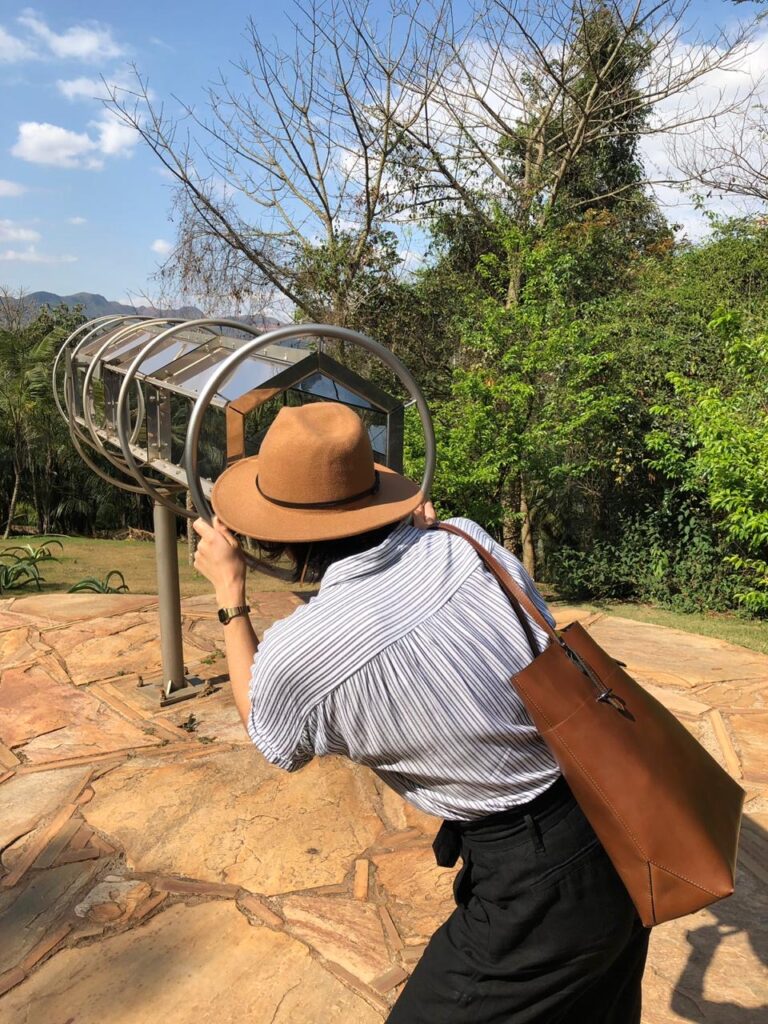
There are no words to describe how grateful and fulfilled I feel after these five weeks of exchange, working together with the San Francisco Bay artists — Stephanie, Jenny, Sharmi, Erik, Marlys, Avital, and Parul. It has been a great pleasure to meet and work with them despite the approximate 6000 miles of physical distance between Vienna and the Bay Area; I have the odd and delightful feeling that I've actually met them in person.
Within the framework of international exchange, I had the pleasure of designing and leading online sessions with the mission of exploring and addressing the social challenge, "In “Search of Truth.” Using feminist hacking strategies as a top-down methodological ground, informed by Post Humanism and New Materialism theories and practices, we rose to the challenge of collaborating, discussing, brainstorming, analysing, creating, imagining, speculating, dreaming, and inventing alternative interfaces to unravel and demystify our perceptions of truth.

In the first three weeks we had six intensive group sessions, each focusing on a particular problem and perspective regarding the main topic, "In Search of Truth.” In session 0, we reviewed codes of conduct and focused on methods and strategies in tackling the theme — we discussed hacking as well as critical and diffractive thinking as possible ways to unravel our perceptions of truth.
In Session 1, we attempted at “Touching the Truth” by asking ourselves, “What to believe?” and “What do I wish to be true?” We accomplished this mission by examining and questioning models of machines that were designed with the purpose of leading users to a certain belief and understanding of truth. Starting with the idea that any search for truth is prompted by a desire for change, we searched for open source tools that might be useful in empowering our wishes. This challenge was our launching pad into practice mode, which was followed by a couple hours of hands-on work to physically build a “touch” sensor made of recycled material.

Session 2 was devoted to the idea of “Demystifying What is True,” with a particular gaze at the truth behind new technologies. Using a more phenomenological approach, we bounced between individual and common situations, from human to non-human perspectives, and back to one of the matters that might establish common ground: water. Hovering on feminist hacking ground, we discussed the importance of caring in re-thinking and repairing the world. The discussion led us to make a DIY electronic circuit that, with the help of an Arduino microcontroller, enabled us to listen to the electricity in each other's bodies.
Session 3, with the title “Touch/Pinch to Believe,” led us to the core of perception and its relevance to the individual and/or collective conception of truth. By looking into the complexities of the proprioception system, we recognised the importance of touch and haptic stimuli in differentiating reality from virtuality. With the use of microcontrollers and vibration motors, we attempted to touch each other, if only virtually.
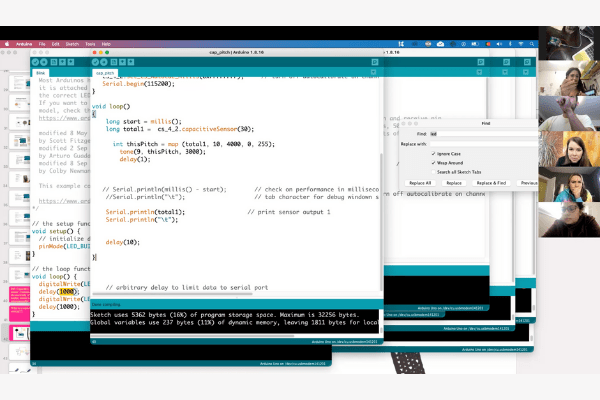
In Session 4, we speculated on truth, thinking outside the box, brainstorming on apparatuses for the future, and ways of expanding interfaces that might be helpful in hacking our perceptions of truth.
In session 5, participants presented their project ideas and feedback to each other. I want to highlight the solidarity and mutual help between the participating artists. At the end of the session, we made sure that everybody was in contact and organised a mutual help-and-assistance network. It was extraordinary for me to observe that even despite the physical distance, participants were able to reach out and empower each other. At this point, by observing the common and safer space we established together, I started to shift my attention from focusing on the final result to the collective effort, mutual support, and work-in-process mentality employed by the participants. What a joyful and rewarding moment!
Not even two weeks had passed and participants were already “ready” to document and present their projects. Together with the amazing web-designer Maya Hilbert, we set the stage to showcase participant projects — the virtual exhibition. Maya Holm and Shamsher Virk joined our working forces and organised the documentation of the projects as well as the text review. Again, another very good example of a successful collective effort. A super-mega-thanks for everybody's support!!!
The live showcase event took place on October 9th and was marked by the presence of panelists Dasha Ortenberg, Rashin Fahandej, and Vanessa Chang, who kindly offered feedback to the exchange artists. Their contribution was central and crucial: along with very positive feedback, they tackled some sensitive points that were not perceived before and brought new perspectives that had not yet been considered. We were all very grateful and honoured by their participation in the event.
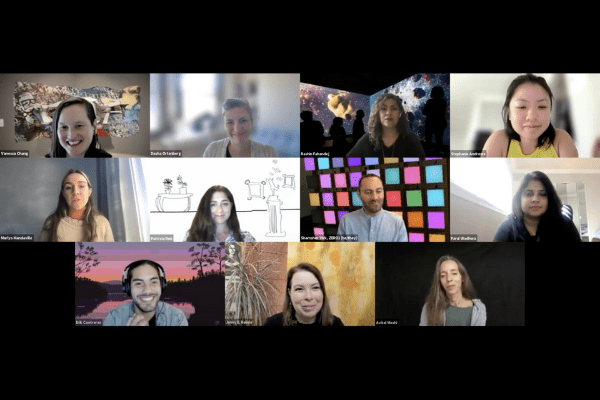
The new media art works-in-progress displayed in the exhibition "In Search for Truth" are statements and essays on how truth is perceived differently within multiple distinct contexts and points of view. A common theme is the wish to unravel the truth by enveloping otherness — whether that is through the self-other or collective-other — which is an aspect that emerged from the deep solidarity within the group. The exhibition expresses a collective concern towards an excessive trust, dependency, and reliance on new technologies in the digital age, either by tackling some of its troubles — such as the digital self, artificial intelligence and mobile tracking — or by speculating on "true" presents and futures. Either way, we confirmed the impossibility of a one-and-only reality, and with that, the urgent need to constantly re-situate ourselves and become aware of the other side of “truth.”
I feel very honoured for the opportunity to work with these talented artists and for being able to follow their process until this stage. Many thanks and congratulations to Stephanie, Jenny, Sharmi, Erik, Marlys, Avital, and Parul!
I would also like to thank Maya Holm and Shamsher Virk for their amazing guidance and support during this journey. I sincerely wish that we keep on searching for the truth together, perhaps in other exciting future projects.
How can a “true conception of reality” be established contemporaneously, and how does it influence us as individuals and as a collective? Is our truth an individual perception or a common belief constructed by the masses? How does truth affect where we are and the way we care for each other (as humans and non-humans)? Is unraveling the truth a way to trigger social change? What makes us wish for change and what are we able to change on our own? Which personal tools or senses do we resort to in order to distinguish truth from falsity? Will the pursuit of truth emancipate us? Ultimately, can technology be an asset in the pursuit and repair of truth, even if used within fictional scenarios?
These are just some of the questions I look forward to discussing and elaborating on with some amazing Bay Area participants during the upcoming four-week online exchange. The workshops will surely challenge us to collaboratively dialogue, brainstorm, analyse, create, invent, imagine, dream, and speculate on alternative interfaces as tool kits to unravel and demystify complex systems (such as the perception of truth). These questions will also help to position us critically towards what has changed, what is changing, and what can be changed in that regard.
Since 2006, I have been teaching and offering hands-on workshops on media art, inspired particularly by the idea of demystifying and "demythifying" the apparatus. My practice is grounded in hacking philosophy and along with many other post-internet artists, I have a lot of fun with subverting the system, reverse engineering, hacking creative processes, defending access, and openismus. One of my main topics of interest is interactive haptic visuality. In my artistic practice, I seek to subvert visuality as a primary mode of experience, playing with technology as a means to expand and stimulate corporeal perceptions.
I also feel very privileged to be part of a feminist hacking community based in Vienna, Austria — Mz* Baltazar’s Laboratory. With the folks in this Hackerspace, I have learned to break with feminine gender scripts, transgress gender norms, and embrace technological challenges through feminist lenses. Feminist hacking is about fostering a culture of fearless making, activism, and provocative thinking from a queer, non-binary, and female* perspective. I believe that these are very strong and necessary tools for individual and collective emancipation that will guide us through this cultural and social international exchange. I am looking forward to learning and hearing from all the participants and hopefully, with a feminist touch, touching some of the truths we wish to unravel.
We will keep in touch!
Patrícia
Feature image credit: Patrícia J. Reis, The Wishing Machine Project (2016). Still frame from dual-channel video installation. Still courtesy of Patrícia J. Reis.
Creative Impact Lab Cairo (2021) converged an interdisciplinary group of 18 Egypt-based visual artists, sound artists, performance artists, film and media artists, designers, writers, and scholars to address the issue of women’s empowerment in Egypt. On what is hopefully the tail end of the COVID-19 global pandemic, the lab was conducted entirely virtually. Despite our distance, I’ve found it truly remarkable how our group forged an intimate and intensive pocket of time together. I’m amazed by how much ground we covered in just a few short weeks.

During the first half of the lab, I had the privilege of leading this group in a series of activities spanning five workshop days. Riffing on the theme of “backups” which I introduced in an artist talk that kicked off the lab, our first four workshop days were aimed at generating content to seed a community media library shared by the group and were organized around four themes. Day by day, our themes were “Time machine backups” (including the concept of “forking” in open source software development and the metaphor of “backstops” in a time capsule free write); “Backpacks” (including an introduction to object-oriented feminist analysis and collectively live-translating Ursula K. Le Guin’s “The Carrier Bag Theory of Fiction”); “Backchannels” (delving directly into the question of what can and can’t be “said” about women’s empowerment and including discussions of secret messages and security protocols for communication); and “Back-to-back media” (including considering the affordances of B-sides and multiple-sided media). Our activities spanned sharing a Zoom dinner, filling and swapping bags, open discussion forums, whiteboard brainstorm sessions, silent COLO sessions, active listening, meditative gift giving, guided free writes, and peer-to-peer skillshares.
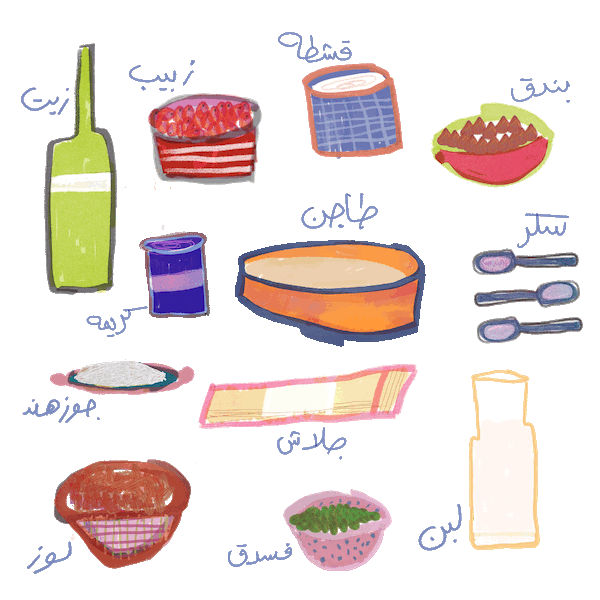
![]()
Two of the activities that made the biggest impression on me were the collaborative real-time translation of Le Guin’s “The Carrier Bag Theory of Fiction” and our group discussion “Broadcasts and Backchannels” about what can and can’t be said about women’s empowerment in Egypt. These exercises were extremely different in form and content; yet both revealed to me the formidable collective intelligence that was arising out of this group, and that these exercises were helping to hone. Both exercises highlighted for me the necessity of addressing the social issues at the heart of our lab as fundamentally multifaceted, and underscored the significance of a polyvocal approach to speaking to these issues as such in order to do justice to the complex intersectional realities of Egyptian cultural experience. For every argument raised, there is another side to consider. And for every strong statement voiced righteously, there is another—perhaps softer—voice simultaneously yearning to be heard.![]()
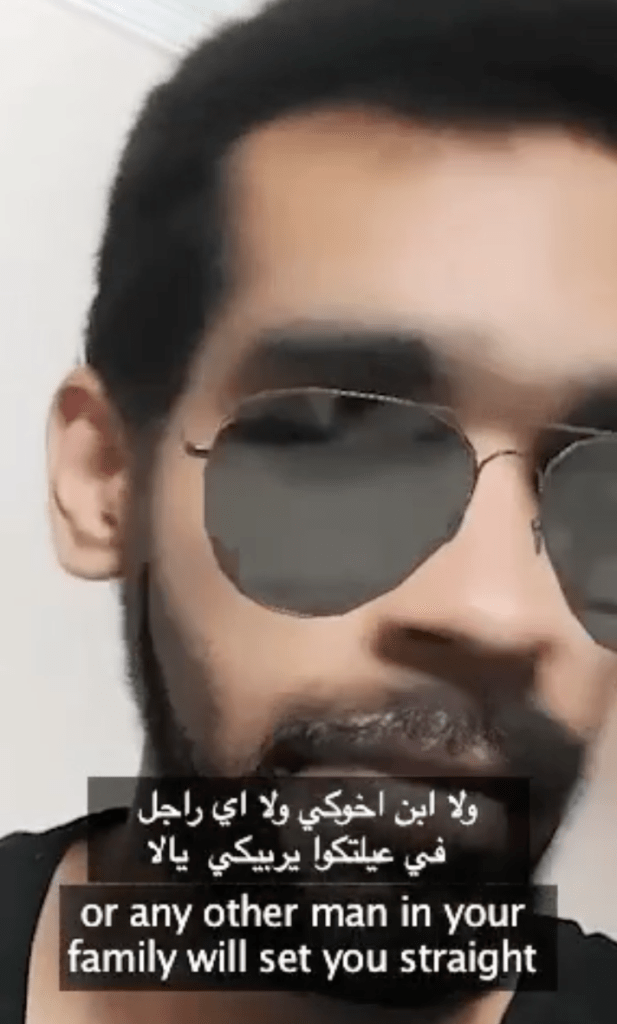
After opening our time capsules at the end of our fourth workshop day, groups started to form around project ideas. On our fifth workshop day, each project was proposed before two guest critics, Elham Khattab of Out of the Circle, and Maya Hilbert of New Media Artspace at Baruch College. With feedback from Elham and Maya, the participants then launched into an intensive 12-day development period during which they created new media art works-in-progress while I curated the proposed works in a virtual exhibition. Drawing on the notion of multi-sidedness, and inspired by our “Back-to-back media” day, I titled the exhibition “Recto & Verso,” referencing a term from book design that refers to the front and back sides of a page.
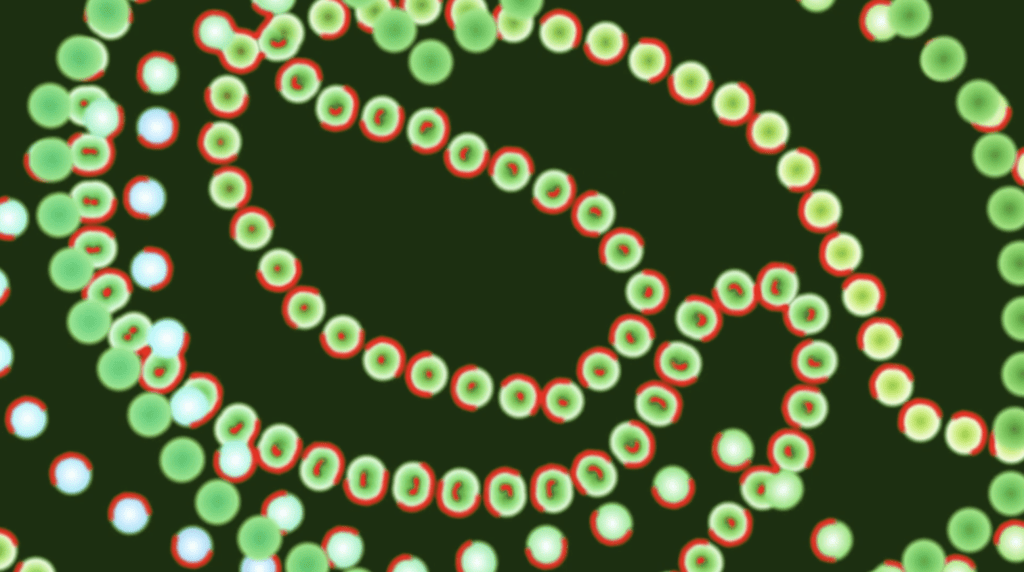
The works-in-progress that emerged speak powerfully to this notion. I’ve been floored by the eloquence and intensity of the work that was created during this short time. I invite everyone to visit the virtual exhibition at cil.medrar.org. Like me, I’m sure you will be excited to think about how the projects that were fomented during the lab will soon be taking new shapes and moving forth—from the lab into the world.

As I think about leaving the lab behind and moving forth toward the next stages of our journey, I am immensely grateful for the time I’ve spent with this generous group of talented artists. I’m grateful for their hospitality in welcoming me into the fold, for being so forthright and patient in sharing with me in the spirit of cultural exchange, and for trusting me throughout this process. In my view, one of the greatest successes of the lab is that many participants have indicated to me that they felt supported in this process. Thinking toward the future, I hope the lab will live on in these discoveries of forms of mutual support, ongoing artistic collaborations, and lasting community.
Feature image credit: Al-Dad by Sara El-Barkouky, Esraa Elfeky, Youssef Abdelmaged, Amany Adel, Ramah Aleryan, Ahmad Aiuby (2021). Image courtesy of the artists.
For over two decades, my interventions in contemporary technoculture have involved opening “black boxes” that proliferate in and around computer culture and challenging cultural assumptions about who participates with emerging technologies. The intersections of gender, race, class, and labor in digital culture (and their contradictions!) are the main subject matter of my work. Likewise, the perspective I bring when I use or critique technoculture and its objects is informed by my own intersectional position as a woman, a multiracial person of color, an artist, a writer, a curator, an educator, and—as this cultural exchange highlights—an American. I am always looking for ways to unpack the realities and identities we take for granted, and to invent and explore alternatives. I approach this process through feminist practices like camaraderie, care, solidarity, sharing, attentive listening, and proactive allyship.
In this spirit, Creative Impact Lab Cairo will foster conversations and dialogue. I am looking forward to learning about women’s empowerment in an Egyptian context. My learning has already begun. With the insightful and indefatigable Rodeina Fouad, I have just completed the humbling experience of reviewing applications and portfolios from 105 applicants. Grueling as this process was, I’m grateful for the exposure to so many diverse viewpoints and some truly amazing work by Egyptian artists!
During the first part of the exchange, I will share ways I work across art and theory. In particular, we’ll be putting theory into practice: By approaching technologies as objects, we’ll apply theories my collaborators and I developed in Object-Oriented Feminism (University of Minnesota Press, 2016). At the same time, we’ll be putting practice into theory: I’ll offer my own practice—specifically, my recent solo exhibition Backups (Mazmanian Gallery, 2019)—as a starting place to reverse-engineer principles of women’s empowerment via digital art. Drawing on Backups, we’ll use touchstones like backing up (as time travel or as forking in tech R&D), backups (as digital archives or feminist comrades), backpacks (as crucibles for women’s narratives and counter histories à la Ursula K. Le Guin’s “The Carrier Bag Theory of Fiction,” 1986), and backchannels (as secure communication protocols for fostering women’s empowerment and sharing women’s stories). Participants will be invited to explore and develop these in their own projects during the second part of the exchange.
While spinning off Backups and various formations of “backs,” I couldn’t help but think of the canonical American feminist anthology, This Bridge Called My Back: Writings by Radical Women of Color, now in its fourth printing (edited by Cherríe Moraga and Gloria Anzaldúa, SUNY Press, 2015). Having managed to locate a copy at a local bookstore, I collected a bag bearing my name in pink magic marker from curbside pick-up and opened it still in the car. The first word on the first page of “Catching Fire,” Cherríe Moraga’s preface to the Fourth Edition, made me catch my breath: “Egypt.” Recalling the excitement that she felt watching news reports about the actions at Tahrir Square, Moraga situates feminist revolution as a shared experience of solidarity in-common. She writes, “To view the world today through a feminist of color lens shatters all barriers of state-imposed nationality,” (Moraga, xvi). I take this as a fortuitous omen and am full of anticipation for the work we will do together in the coming weeks.
Image credit: Curbside pick-up of This Bridge Called My Back (left) and a positive omen in the preface to the Fourth Edition (right). Photos by Katherine Behar.
Over the past half century, the Grand Theater on Mission Street has been home to a cinema, a dollar store, and now an eclectic creative community of media makers. This group of artists and producers has assembled around Gray Area’s revitalization of this historic Mission District building. As an invitation to join this creative community, Crowbar Corner, Gray Area, and ZERO1 have teamed up to launch the Grand Creative Resource Library — a lending library offering the tools needed to make your own media art.
Paired with access to workshops, labs, incubators, and events produced by the contributing partners, this collective resource will eliminate barriers to creation at the forefront of art and technology. Our shared vision is to put creative power into the hands of fellow community members who want to express themselves in innovative new ways, regardless of the resources they may have available to them. Bridging the digital divide begins with a sharing of resources and skills. The network formed through this simple reciprocity will bind the creative community we build together.
The Library launches on May 19, 2021 with an initial focus on tools to create electronic music and sound art. Thanks to a generous donation of unique analog synthesizer equipment by New Systems Instruments, Mr. Bill, Shawn Allen, and Ryan Smith from Crowbar Corner studio, paired with MacBook Pros and iPads loaded with Ableton Live, VCV Rack, and other production software, we will be making available portable, self-contained, sound studios.
Borrowers from the Grand Creative Resource Library will receive a basic orientation to the equipment they check out. They will then be given priority access to active workshops in the Grand Theater community that employ these tools. We are proud to offer resources to sustain and advance an inclusive creative community. The Grand Creative Resource Library prioritizes opportunities for students and creators from diverse backgrounds that are underrepresented in the fields of art, music, and technology.
Those interested in borrowing our equipment to realize their sonic dreams can access the request form on the Grand Creative Resource Library page.
The Grand Creative Resource Library is a collaboration between Crowbar Corner, Gray Area, and ZERO1.
Crowbar Corner is an electronic music production studio with a unique collection of instruments both vintage and modern, high end monitoring and I/O. It has been the laboratory for acclaimed electronic music releases as well as cutting edge sound art and large scale performances at the Gray Area Theatre. Members: Ryan Smith, Marc Kate, Jacob Sperber. https://grayarea.org/create/crowbar-corner/
Gray Area is San Francisco's premier cultural hub catalyzing creative action for social transformation – applying antidisciplinary practice towards some of the most complex challenges facing our world. Gray Area’s mission is to apply art and technology to create social and civic impact through education, incubation and public events. www.grayarea.org
ZERO1 is a nonprofit arts organization that addresses complex social challenges by producing community driven emerging media and digital art projects. We believe that artistic experimentation with emerging technologies inspires novel creative strategies and broaden our critical understanding of the world. Through a global network of partners, we bridge governmental, academic, corporate, and cultural worlds to build engaged and vibrant communities that drive social action. www.zero1.org
The Music Concourse in San Francisco's Golden Gate Park comes alive with a Saturday crowd — people lining up for the SkyStar Observation Wheel, out for a stroll through the Japanese Tea Garden, biking past on their way to Ocean Beach. Amidst the bustle on a sunny day in early April, several people can be seen standing notably still, pointing their phones towards the statues and monuments distributed around the courtyard. Mimicking the poise of the statues before them, these stoic figures looked inquisitively at the screens in their hands, scanning their surroundings with concentration and curiosity.
The mysterious sights and sounds captivating these observers are the artistic interventions of seven local artists who had crafted augmented reality (AR) artworks responding to a selection of public monuments in the Music Concourse. These interventions were created during ZERO1’s Marble and Media: Digital Activations of Public Memory, a six-week laboratory led by artists Cheyenne Concepcion and Camila Magrane that culminated in the creation of an AR walking tour. The lab endeavored to provoke thought and encourage reflection on the role of monuments as venerated objects of public memory.
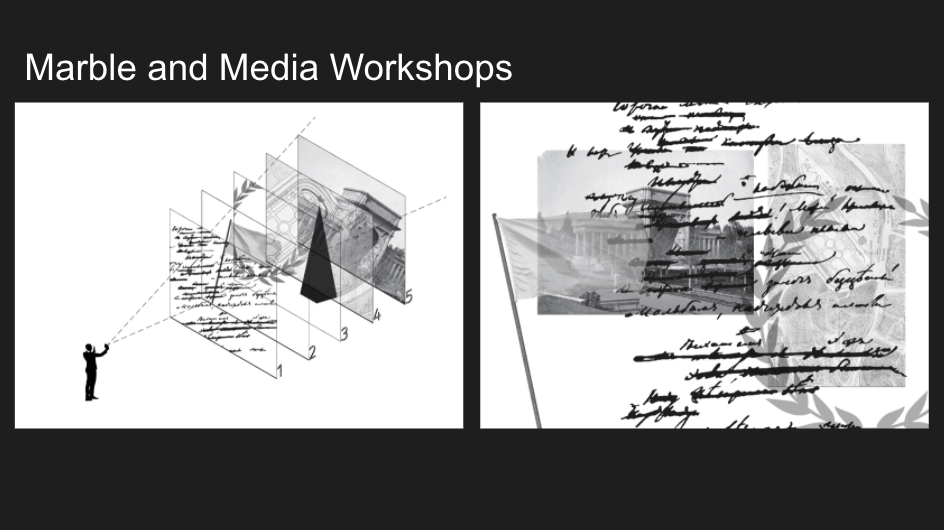
Images courtesy of Cheyenne Conecpion.
In recent years, heated national discourse around monuments has sparked a collective assessment of our shared history. Public outcry demanding the removal of statues honoring racist Confederate generals has grown into a broader national reckoning with celebrated figures who, at worst, represent oppression across American history, and at best, represent only a part of the story.
During the summer of 2020, in the wake of the police killing of George Floyd, as an uprising for racial justice swept across the country, the Music Concourse became a site of righteous protest. Activists gathered to remove the statues of Francis Scott Key, Ulysses S. Grant, and Junipero Serra for their complicity with the racist practices of their day. Key owned slaves, Grant inherited a slave (who he then freed, it should be noted), while Serra forced conversions and banned indigenous cultural practices. These three figures (all white men) are just a sampling of the characters who populate our official public memory, each requiring nuanced evaluation to understand the role they played in our history. With these statues now gone, we’re prompted to imagine — what might take their place? And what are we to make of the rest of our monuments, even those that were untouched by last year’s protests?
At ZERO1, we propose that artists have an important role to play in this reimagining. The prototyped artworks from Marble and Media surface untold stories about the park itself, and give deeper meaning to the figures represented by these revered objects in metal and stone. They ask us to drop in and feel out a sense of place in space and time. The heavily-irrigated bit of landscaping that is Golden Gate Park, located on a strip of land that was once sand dunes stewarded by the Ohlone people, and known in the 19th century as the “Outside Lands,” becomes a stage for the telling of our many shared stories.
Several works draw our attention to the natural world and a time before the arrival of European settlers. Jeff Enlow’s American Bison reproduces the over-hunted majestic beast of the plains as a reminder of its near extinction by settlers and current restoration by indigenous nations. We are introduced to several plant and animal heroes of natural history in Mae Ross’ This Land before it was “Found,” honoring the pre-colonial beings who inhabited this place long before settlers arrived.

Collage work by Paola de la Calle (left) and Jeff Enlow (right).
Through the artists’ eyes, we are invited to see the familiar anew. With Verdi, Shrouded, Kim Nucci animates the Guiseppi Verdi monument with sound emphasizing the monument’s connection to Italian nationalist history and the forcible relocation of Italians during WWII. Hannah Scott proposes a Speculative History that captures multiple layers of truth by overlaying a matrix of contextual knowledge upon the statue of General Pershing. Paola de la Calle reclaims the pedestal where Junipero Serra once stood as a Monument to the Movement that has demanded reconsideration of problematic historic “heroes.” And with Plant Your Seeds, Hena Muttreja fittingly honors John McLaren, known for his dislike of monuments, by obscuring his bronze form with the thing he loved most, plants.

Video stills from demo videos of augmented reality pieces by Hena Muttreja, Hannah Scott, and Mae Ross (left to right).
Creative response to the architecture of dominant culture can also release the tension built into these structures, opening up a space for reinvention. Caleb Lightfoot’s Schema for a Post-Historical Monument deconstructs the neoclassical pedestal and columns that once held the figure of Francis Scott Key and suspends the component parts for examination in an act of critical archeology.

Sketches by Caleb Lightfoot.
The tool of AR is particularly well-suited to these experiments in public space. While the technology remains somewhat glitchy and sometimes inaccessible, its potential was on full display during the Marble and Media AR Walking Tour. As the name suggests, it can augment what already exists in our physical world by adding a layer of image or sound. It can make an ephemeral mark on the world that literally disappears when you want it gone. It provides a canvas for experimentation, perhaps to aid planning towards the eventual construction of a permanent structure. AR is a tool for transforming a place without leaving a trace.
While the San Francisco Arts Commission conducts a review of monuments in the City collection and convenes a Monuments and Memorials Advisory Committee, an official process that will take well over a year, there is a timely opportunity for artists to enrich the discourse and expand our thinking around memorialization right now. The artists of Marble and Media heeded that call, and we hope many more will follow.
Marble and Media: Digital Activations of Public Memory is a ZERO1 creative laboratory co-led by artists Cheyenne Concepcion and Camila Magrane in collaboration with New Monuments Taskforce and emerging artists from across the Bay Area which utilizes new media to explore monuments and memorialization in public space.
Header image is a remix of "Golden Gate Park, Music Concourse" by Michael Estigoy, used under CC BY-NC 2.0.
Open house for “Lima 2100: Collective Resilience through Adaptive Urbanism” in the virtual Museo de Arte Contemporáneo (MAC Lima) gallery, created and curated by Gabriel Kaprielian exhibiting work of American Arts Incubator — Peru artists (2020).
It’s been a little over a month since the American Arts Incubator — Peru (AAI Peru) program was completed. Reflecting back on the month-long exchange, the global pandemic and virtual format did not dampen the enthusiasm and brilliance of the participating artists. Instead, it challenged us to adapt and respond to the moment, framed by the past, while projecting onto the future. Meaningful connections were made, ideas and knowledge were shared, and amazing new artwork was created. By all accounts, the program was a huge success! Thanks to the dedication of many wonderful people that made this possible.
I led four workshops that introduced technology platforms, theoretical frameworks, encouraged discussion, and led to short exercises applying these tools with artists' ideas. Workshop 1 involved a collective “Psycho-geographic Mapping” of Lima using a virtual whiteboard canvas. In Workshop 2, artists created “Postcards from the Future” that showcased speculative visions of Lima in the year 2100. Workshop 3 introduced tools for digital 3D modeling to create a collaborative “Monument to the Pandemic.” Workshop 4 demonstrated the use of augmented and virtual reality to visualize the artists' work.
There were two guest speaker panels that introduced further discussion on the social challenge of urban development in Lima, focusing on the themes of climate change, social equity, and urban health. The first panel was centered around public space and included Dr. Patricia Kim (Monument Lab), Dr. Ghigo DiTommaso (Gehl Architects), and Lucía Nogales (Ocupa tu Calle). The second panel focused on socially-responsive artwork and included Nicolas Gomez Echeverri (MAC Lima), Natalija Boljsakov (UTEC), Ferran Gisbert (UTEC), and Kiko Mayorga (UTEC).
For the last ten days of the program, each artist created new artwork responding to the theme, “Lima 2100 – Collective Resilience through Adaptive Urbanism.” These works took the form of 2D collage, audio and video, and digital 3D forms. I was amazed by the creativity and thoughtfulness of each project and the passion each artist demonstrated in developing their work in such a short amount of time.
Artists presented their artworks and concepts to a guest panel where they received outside feedback. The final exhibition was originally planned to take place in the Museo de Arte Contemporáneo (MAC Lima). Instead, we created a virtual reality gallery in Mozilla Hubs of MAC Lima with a curated exhibition of each artist’s work. This was the first time we were able to gather in the same "room," walking around and chatting, viewing the artwork as a collective project.
I want to give a big thank you to all of the participating artists, our partners in Lima including UTEC, MAC Lima, and the U.S. Embassy, as well as our guest speakers and panelists. This program has introduced new ideas and understanding in my creative practice and expanded my ecosystem of collaborators. I am grateful for the opportunity to have taken part in AAI Peru.
Since the tragic killing of George Floyd on May 25, our staff have been in deep listening mode — thinking and discussing internally how to most effectively act in solidarity with the Movement for Black Lives in the pursuit of racial justice.
We continue to mourn the incessant violence enacted by police on the unarmed bodies of black citizens such as Breonna Taylor, Tony McDade, Rayshard Brooks and so many more. As our collective resistance grows, we are witness to the tactics of intimidation, escalation, and excessive force used by agents of the state against protesters. The broader systemic failure of these publicly funded agencies, allegedly tasked to serve and protect, is being laid bare.
We affirm that there will be no justice in this country until we acknowledge that all black lives matter and we begin to reshape our institutions in support of that belief. The scope of policing must be reduced, while the reach of social services, health care, education, and cultural activities must grow. The coming reinvestment in communities will require a critical anti-racist approach, if we are to move together towards justice.
As a nonprofit organization at the intersection of art, science, and technology, we acknowledge that the nonprofit industrial complex, the arts sector, the production of scientific knowledge, and the development of technological innovation are all embedded within oppressive systems that have perpetuated white supremacy. As an historically white-led institution, we carry a legacy of privilege that must be examined, unpacked, and reorganized in order to move forward in service of equity and justice. Working with media artists who are experimenting with emerging technologies and new tools, our work is fraught with technological fetishism and obsession with novelty. With our gaze oriented towards the future, we can either blindly pursue creative innovation in service of inequitable resource accumulation, or we can choose to apply our creativity to reimagine a more just, inclusive world. Our call to action is clear.
We have begun a strategic planning process that will provide a framework for change in our organization, taking into account contemporary conditions: the growing momentum of the movement for racial equity in our home communities and the localization of activity due to the pandemic. As we embark on this work, we commit to the following actions:
Internal Actions
External Actions
As members of our community, we rely on your perspective and collective wisdom to guide us in our work. We invite your comments and reflections on the work we have done and the proposed actions above. Please be in touch and share your thoughts so that we may refine our efforts.
In solidarity,
Team ZERO1
by João Henrique Motta (photographer, trained journalist and artist-in-the-making via AAI Brazil)
*Leia a postagem do blog em português / Read the blog in Portuguese
On the night of Thursday, March 12, 2020, American artist Santiago X exhibited a video of his piece, "ATICINTOLOCA: Man and The Black Snake” to a full auditorium at the Banco do Brasil Cultural Center in Belo Horizonte (CCBB BH). The performance of the indigenous-futurist artist, born to the Kossati and Chamoru nations, recreated the experience of the formation of mountains from a projection of contour lines in mixed reality: the digital and the physical. We immediately identified with the topography as inhabitants of a country full of mountains.
Santiago X, or Santi, was the mentor who guided about 20 Brazilian artists, gathered in Belo Horizonte, to participate in the international digital arts exchange program, American Arts Incubator - Brazil (AAI). It was Santi's first time in Brazil, and the residency experience was divided into two parts by an unexpected historical moment of our century: the dawn of the new coronavirus pandemic.
The work that Santiago presented to us during that meeting was a reference to the myth of the creation of the mountains in the territory of his people. As he used his hands to move mounds of sand inside a box, a projection drew new landscapes, adding peaks, depressions, plains and mountains. The green, blue, red and yellow, colors characteristic of this type of map, colored the image throughout the time that he stirred his work. It was possible to perceive, then, the importance of the element "earth" within the artist's work. A westernized conception could certainly be limited to the geological characteristics of the soil. But in the eyes of those who have a deeper relationship with the nature of a place and the land itself, it was impressive to witness the materialization of a worldview being activated by means of technological devices.
At the time, I remember asking Santiago about when or how he incorporated the term “indigenous futurism” into his work, and he said something along the lines of: “My relationship with futurism is to rescue the connection with my land (earth) and with the knowledge of my ancestors, to tell our stories from art. I continue to tell stories about the life and memory of my people, also in augmented reality.”
In his production, the artist uses multiple platforms to bring ideas to life and to establish connections with other people. It was not by chance, that same night, that the presence of a group of students from the UFMG Landscaping course contributed to a very genuine approach to the occasion: to know and hear Santiago's words. I also needed to hear it and get to know it. It was beautiful, and there I felt that the residence would be a fertile experience to question almost everything.
After the opening of AAI, some people went to a bar near the cultural center to celebrate the opening. Sandro (Santiago X’s assistant), some production professionals and a group of participants, among them the architects Roberta Silvestre, Kyvia Salles and myself. We didn't know it yet, but we would later form a working group together - Group 4.
Together, we toasted, drank and ate.
THE FIRST PART
The first meeting with all the workshop participants took place the following weekend. First, we introduced ourselves and shared the objects we wanted to create in a world of immersive reality. It was intense.
We then took the first steps with the tools we would use to create group installations for an exhibition in one of the rooms at CCBB BH. A discussion on the concept of “reality” introduced the points of focus that we should consider in our future work: economic inequality and protection of the environment.
In the last five years alone, the territory of Minas Gerais has suffered two of the most serious environmental crimes in the world: the rupture of the Samarco and Vale dams, which destroyed many lives in Bento Rodrigues and Brumadinho, generating consecutive tragedies and successive violations of life for families and entire cities.
However, the Friday after the first weekend of workshops, Belo Horizonte joined the long list of cities in the world in which city officials decreed the closure of commerce and instructed people to stay at home, following health recommendations from experts.
At first, the conversation was about washing your hands. With the interruption of the activities of the CCBB, American Arts Incubator was postponed.
THE WORLD IN QUARANTINE
In Italy, there were 700 deaths a day. Almost a thousand people per day, dying in a country where all the civilizing myths of the political, economic and health systems seemed to have stuck to reason. But not everything is as it seems. Then, the British prime minister, who had been a denialist regarding the global transmission of the disease, contracted COVID-19.
Closing borders, closing establishments, closing houses. The world was emptying, and the European continent was the new epicenter of the disease. The material world had been contaminated. And the pandemic, following its natural course, started plaguing our continent: South America.
I called my friends. For a long time, I will remember that day. And also those solitary numbers. 15 dead. It was Saturday. After a few days, the scenario of the pandemic would be like that of a horror movie: cemeteries full of people wearing plastic paraphernalia to contain the transmission of the virus.
Those who could, stayed at home. Some still left. Others insisted on promoting gatherings. Most still needed to buy food, and for that, they needed to be out. Not everyone could protect themselves from this violent wave.
Are we still in shock? Or did we get used to the shock? Did it already pass? What is happening? Deaths increased and continue to increase.
How did we possibly get here? Did we make mistakes? We must have. How do we fix them? Here below the Equator, imagining any possibility of the future is flirting with the surreal.
"Where did we come from? Where are we going? Do these questions matter now?”
This is the initial message of "HABITAR (DWELL)," a collective work that results from a collaboration between the architects Roberta Silvestre and Kyvia Salles, and me, João Henrique Motta, a journalist. The provocations of the work seek to offer questions about reality - and also about the possibility of creating futures.
The collective experience we shared was guided by a very particular process of matching ideas between the group. We listened, stopped, talked and decided together on what to create. From analyzing how our skills complemented each other, we reached a consensus and finally began utilizing visual and digital tools, as well as developing concepts and narratives.
When JA.CA communicated by e-mail about the possibility of restarting the residency, now in a virtual way, respecting sanitary rules and preventing crowding, that was reason enough to cheer us up in a quarantine full of uncertainties, and also infinite possibilities to stimulate artistic thinking.
Focusing on the themes that would be part of this experience, economic inequality and environmentalism, allowed us to consolidate aspects that united the propositional and narrative interests of our large group. Valuing the protection of nature and telling the stories of its guardians was one of the fires that brought us together to tell stories, ask questions and imagine futures.
Mining is undoubtedly a scar that for years has made this land bleed, year after year, in an exploitative regime that depletes mountains, forests and rivers, terrorizes cities and interferes with the way of life of so many people. And impunity makes our reality even more cruel. This exploitation would be at the center of our criticism. Brumadinho and Bento Rodrigues can never be forgotten.
Other environmental crimes that have successively occurred in recent months have also added to our chorus of warnings: criminal fires from north to south, tons of oil off the coast of the Northeast, invasion of indigenous lands by illegal mining, floods and landslides in the cities. In addition, we have a state authority that arms itself and declares an explicit war on alternative lifestyles to hegemonic capitalism, as I will discuss later.
Defending the environment is defending the constellations of ways of life and the stories that make up our trajectory: the indigenous peoples of Brazil, the black population, the poor population, the traditional communities — everyone who lives on the margins of “humanity.” Respecting these stories is fundamental to the message we seek to learn and convey.
In early May, we met again on the Zoom platform. Santiago in Chicago, and us in Belo Horizonte. Later, we met with panelist João Souza, creator of the NGO Favela, to comment on the exhibition resulting from the residency, aiming to continue the group activities. That was one of the most vital points of this process: an opportunity to dialogue with someone who encouraged us to further sharpen the critical dimension of our projects and helped us look directly into the eyes of the inequalities that make up Brazil's economic and political structures.
Finally, Santiago X decided that the virtual exhibition of the AAI would be called "PORTAL."
UNLOCKING
“Natural resources for what? Sustainable development for whom?” asks Ailton Krenak, in the book, Ideas to postpone the end of the world (Companhia das Letras, 2019).
Save what, if the land gives us everything? How can there be a lack, if the forest is the symbol of abundance and diversity? For the indigenous peoples of Brazil, ancestral territory is sacred. Nature is the greatest wealth, and it cannot be violated for the advantage of the violent.
"HABITAR (DWELL)" is based on a poetic reading of the books of the writer, activist, indigenous leader and one of the founders of the Union of Indigenous Nations (UNI), Ailton Krenak, and also of the poem "Triste Horizonte" (1976) by Carlos Drummond de Andrade (1902-1987). This work was created with architectural tools, digital modeling, music, soundscapes, poetry, literature, photography, 360º videos and other virtual reality technologies.
Freely interpreted, Krenak's words echo in our work, allowing us to imagine realities, mix cosmos and materialize our dreams in the virtual world. The author emerged as a common reference to all participants in the AAI residency program, both because of the revolutionary power of his ideas towards the decolonization of the gaze as well as the combativeness inherent in his words.
Our concern, then, starts to be deconstructed to the same extent that we approach art from the advice of Santiago and Krenak. Santiago pointed out two fundamental points for thinking about our worlds: "abstracting" and "healing." It was these terms that drove us and allowed us to have such honest exchanges about expectations around our work.
The forest is a gift from our ancestors, who planted it as a garden. It is not, therefore, a random cosmic phenomenon, dependent on something like the alignment of the stars and the expansion of matter, but rather on the historical action of human groups in tune with the entities that live there. These and other indigenous wisdoms have expanded our imagination for this work.
Working with a digital platform of scenic architecture and scene description, while still having the possibility of conducting experiences of other natures, filled us with a feeling inherent in artistic enjoyment: inventing. And we invented everything: first, paper; then, the cards, the photos, the collages and the slides.
A continent plagued by environmental problems, an empty city, but still noisy. A world in the process of reforestation and a community in celebration. Everything perfectly transfigured for the virtual atmosphere, for the internet.
VIRTUAL RECREATION
It all happened by combining the skills and reflections of three young artists from Minas Gerais who borrowed the words and ideas of others, among them classical and contemporary thinkers.
When we imagined the experience, placing the work in a virtual reality universe like Mozilla Hubs (which at the time we knew little about), we believed anything would be possible. We imagined worlds that would have videos as a ceiling, 360º footage as satellites, poetry echoing in space, and nature continuing to provide life in the environments. A biological and spiritual experience of reforestation. And this is what "HABITAR" became.
That would be our contemplation for a world that seeks healing. This was the genesis envisioned by three artists from Belo Horizonte: a world that interconnects different pasts, presents and futures.
KNENAK MEANS “HEAD OF THE EARTH”
Mr. Ailton is a political and revolutionary leader, who at different times in his life, actively participated in the consolidation of the political and subjective rights of indigenous nations in Brazil. In his most recent books, he talked about his land, near the Rio Doce ("Watu") and about dreams.
Along with “his generation,” he was one of the founders of the Union of Indigenous Nations (UNI) in 1979. Created from the union of several activists, the organization has been responsible for the unification of the struggles of indigenous peoples who have been fighting colonization since 1500. He also participated in the Alliance of the Peoples of the Forest, in 1987, alongside Chico Mendes, activist, rubber tapper and protector of the Amazon Forest. Both Mendes and Krenak are Brazilians who inspire the work of other activists around the world.
The extractive period idealized in the years leading up to the debates on the rights and guarantees of the peoples of the forests would be a solution against the landowning capital that destroyed and destroys the Amazon. Hundreds of families of rubber tappers gave up hectares, “plots” of land in the Amazon biome in order to take care of the tropical forest, joining the struggle of indigenous peoples for the protection of their sacred territories.
For the world of CPFs (Natural Persons Register) and CNPJs (National Registry of Legal Entities), what was at stake was the autonomy of the constitutional law on land. After all, if a certain right is in the Constitution, it needs to be guaranteed. But there is no word in Portuguese or Federal Law that translates an individual's relationship with his birthplace, with the meaning it has for an indigenous person or for a rubber tapper like Chico Mendes. The self-protection of forests by the communities that resist there, creating opportunities where humans respect all other beings, living in balance, is also an experience that we try to express in our work. Chico Mendes was murdered in his backyard within a year in which the new constitutional laws of “redemocratization” were starting to be debated. The legacy of his struggle lives in the daily life of exploited communities and among his companions.
What has happened, in practice, is that the Brazilian State has committed itself to giving total individual and collective protection to the indigenous territories, as well as promising the demarcations soon after. They also promised the same nations things that no other westernized nation can guarantee to the other: peace. Something white folks promise. Indigenous peoples were considered Brazilian and their rights and guarantees would be protected by law - for the first time since the invasion of their territories. As usual, these achievements and milestones remain on the alert, resisting the destructive power of capital. More than ever, the state is declaring a war against nature. The difference is that today, in the head of the (anti) Minister of the Environment, this is the final battle. "A land where nothing can be sold":
These ways of life, propositions of universes and alliances, are political experiences of resistance in our territory that also helped us to imagine the expressions proposed in "HABITAR." According to the photographer and ethnographer Edgar Kanaykó, from the Xacriabá nation, it would be necessary to “indigenize the screens,” “indigenize the knowledge production processes.” In his view, this would be a process that comes from the inside out, from increasingly powerful subjectivities, forming a more powerful collective. As we respect the complexities of these constellations of subjectivities, sharing respect and cultivating care becomes easier.
INVASION
The racial issues unresolved by Brazil and the USA are the reasons for our problems, deficiencies and inequalities. For centuries, the proclamation of whiteness has been a cancer for humans. The assertion of a fictitious superior quality based on skin color is a declaration of war against non-whites. The proclamation of a superiority that decimates entire universes, based on the cruel imposition of a single way of life based on accumulation, competition and the standardization of existence.
Decolonizing is necessary at all borders: in health, education, security and also in the arts. Only then would it be possible to conceive the preservation of diversity as the real meaning of our existences, individual and collective.
We speak of an enemy that has no form, but exercises the power to kill, invade and destroy. Colonialism can be presented in several ways, but perhaps the best way to say it here is to point to structural racism and the distractions that this system creates with the intention of alienating us from the earth, dissociating us as organisms integrated into this planet, to separate us from this possibility of joint existence: on the one hand, humans, on the other, nature. But "everything is nature.”
In Brazil, they are killed with unique impunity. And the non-white population of this "piece" of land for more than 500 years, called America, is killed with unique impunity. In this sense, another reflection that we extract from Krenak is the idea that, if some are treated as second-class citizens, we do not, in fact, form a humanity. Blacks, indigenous people, ciganos, the poor and caiçaras do not enjoy the same “guarantees” as a white person - that is a fact.
Communities that offer us life practices and conceptions of different worlds from the hegemonic system have always been in the crosshairs of colonization. Centuries later, continuing to learn the forms of resistance of these traditional communities should be a political gesture of respect and reverence. Especially in a country where all material relations are the product of enslavement. “Our world” was built on top of indigenous cemeteries and built with the sweat and blood of African peoples, abducted from their ancestral territories.
The experience that our group created corresponds with a universe arranged on a virtual reality platform, in which each participant can visit four different planets and choose, at the end, the one he would like to inhabit. It is an invitation to rethink the past, reflect on the present and imagine the future. Kyvia and Roberta are brilliant architects. They created the old cities of a real world and our inventions.
At this point, we had an idea: the great human mission should be to preserve the knowledge that connects us with life on this planet. But how can we do this if we are not a humanity? If all inequalities point to an unequal humanity? There can be no peace if some are treated as targets.
BELO HORIZONTE AND THE MOUNTAIN
The poem “Triste Horizonte” (“Sorrowful Horizon”) by Carlos Drummond de Andrade is the basis of another narrative configured in the past-future-present. During the coronavirus pandemic period, it is impossible not to approach everything that art offers us in the context of distance, lockdown, isolation, quarantine and such.
The poet's verses were written in 1976, in the city of Rio de Janeiro, where he lived until his death in 1987. According to a report by the artist, the poem was inspired by a news story about security forces that barred climbing and hiking in the Serra do Curral. The sad farewell to Belo Horizonte moves us from the melancholic look at the destruction of the same mountain range by MBR, a mining company that was exploiting the mountain at that time. It is a process that has exhausted the same mountains for decades and, thus, also destroyed a living part of the mining people. From time to time, after all, ore price crises disturb the fullness of our mountains.
Mining has left cruel marks in the country for centuries, and in the last five years, two environmental crimes in Minas Gerais, involving one of the largest companies in the world, have revealed an even more cruel face of successive violations of rights in this type of crime. Environmental crime.
Looking at Belo Horizonte as still provincial, but a “stage of the new arts,” is another interesting point of the same poem. This point connects us to the current moment of cultural profusion in the city, as well as to a generation that seeks the real infusion of diversity in the cultural melting pot of the urban environment. Excerpts from the writer Paulo Eduardo Correa, a key figure in hip hop from Minas Gerais, and a song by the rapper Djonga contribute, finally, to critically fill the work, helping us to propose dialogues with different social realities.
Belo Horizonte is a Brazilian city with many social and environmental problems. A city that grew during the blossoming of contradictions inherent to the formation of our country. Belo Horizonte is a promise, like all other capitals. It's a mystery. "Provincial,” "an egg," “has that hill": Belo Horizonte, that darling, a city that only the natives themselves can complain about.
Among its social and environmental problems, we seek to address mainly two: 1) the destruction of nature and the landscape of this place by mining companies, associated with the interests of capital that devastate our mountains and rivers throughout the state; and 2) the social and racial inequality that, although stark, is totally invisible on the streets of urban centers, where we have the greatest concentration of economic disparities and the State perpetuates a continuous genocide against the black and poor population.
From the beginning, the program’s proposal invited us to leave our own comfort zones, reflecting on the different realities that we experience daily. For a while, I, who was able to stay at home during the quarantine, thought: “everything must be different outside.” But no: nothing has changed - and nothing is normal. There is no normal, and there can be no normal in a reality in which the relationships of life are based mainly on experiences of accumulation, consumption, segregation and continued violence.
This unrest took our group to the streets of Belo Horizonte in the middle of a pandemic. Due care was taken to avoid contamination and transmission of the virus during all our excursions through the streets - not empty - of the hypercenter of the capital of Minas Gerais.
The city was functioning as if there were no measures of restriction and distance. To understand this situation, it is necessary to review all centuries of Brazilian history, but the point to which we would return is the same: privileges of some and lack of access to basic conditions for many. Amidst this scenario, rhetoric about meritocracy still flourishes. There is definitely, in addition to many others, an interpretive crisis in this country.
When we received our tech kits through the program, we went to record the streets to create our current world. Bring the images of our territory, our city, this falling land, to our virtual world. A look at the present to make our future possible.
EXPERIENCE: HABITAR
Imagine moving through a mystical universe, being able to view, run and fly through different spaces. You cannot touch anything, you cannot carry anything and you cannot take anything. You can run, fly, walk, listen, see, take pictures and stay still.
The importance of the experience was being able to tell stories around a “cold fire.” I heard this expression in a conversation between Edgar Xakriabá, photographer and indigenous activist, and Ailton Krenak on Instagram. They spoke of the present moment, filming a sunset in the landscape of their villages during a “live” session.
We now have the ability to meet with "friends" around a "cold fire.” A technology that our ancestors invented to feed us and to help us communicate better, share stories and create emotional bonds.
We have been affected by many stories during this period of the pandemic. I think we all tried to invent universes and possibilities for creation, through art and technology, that proposed reflections beyond reality. They are reflections on the future and on the conditions of inequality pulsating in our society, which cannot be normalized into a pacified “human condition.”
“How can the representation of possible worlds be made by the multiple subjectivities that compose it? How can we integrate the responsibility of co-creators into these narratives? In the perfect condition, we propose a game. We are offering a determining choice: to choose the planet you want to inhabit. What would you do?"
“PORTAL” is Santiago's proposal for four heterogeneous groups of artists, who until March were concentrated in Belo Horizonte and surrounding regions, then had to retreat to their homes during the pandemic. Within its limitations and possibilities, four of the most beautiful works of art I have ever seen were born. Retomada (Resumption), Aguapé and Zona de Segurança (Safety Zone) are worth special contemplation.
In any case, this work made us build portals between our worlds, our homes and our subjectivities, in the midst of a period of social isolation. It was a call to reflect on this collective existence in the midst of all the uncertainties and perpetuated violence, further accentuated by the mourning of the fallen. In collective mourning, we found a way to express ourselves.
The collective imagination of social and environmental tragedies is part of our history and allows us to be courageous and inventive. All the members of this program made their work a message about the dignity that we want to see for all "others" - and not just for "us."
All projects used cutting-edge technologies for the creation of the works. This, in itself, already offered us a “new” experience. But “PORTAL still depends on primordial knowledge: the integration of the individual with nature as disruptive ways to think about life.
Stop and look at the past, let’s learn all over again from those who were always teaching us. How will we create the future? Will we do it together?
All AAI Brazil projects can be experienced at www.aaibrazil.com
The entirety of this experience, from beginning to end, is something I will cherish and continue to be inspired by as I go forward in my art practice. From the relationships forged on the ground to my amazement of the vision and voices of the participants, and for our entire team’s resilience and creative pivoting in response to the pandemic, I am forever grateful.
When I arrived in Belo Horizonte, there was a charge in the air. It was something that was hard to pin down in the moment; it felt like a fire inside. After talking with people, learning their stories and their struggles, as well as their similarities to people I knew back home, the urgency to amplify the humanity in our shared experience burnt in me like a beacon. Whatever was to be created in this short time we had together had to transcend convention, and inject a much-needed narrative into the often cold landscape of art and technology — breathing life into it.
There were a lot of meaningful exchanges and experiences along this journey, but the ones that really stood out to me were the events that inspired us to create portals for healing — and to witness the participants embrace and overcome the challenges of creating team-based virtual experiences while in physical isolation.
Upon my arrival in Belo Horizonte, Francisca of our host partner JA.CA, took me to the opening of a new exhibition entitled "VAIVÉM," which showcased the work of Indigenous Brazilian artists and the narrative of the hammock.
There, I met an Indigenous artist and healer named, Iba, who sang traditional healing songs and linked those songs to the murals he had painted on the walls. I talked with him in my native language and he talked in his; we were laughing at the similarities in our creation stories and symbologies, and he told me his work was entirely about building gateways for healing, or portals. We laughed again, because that is exactly what my practice was/is and what I wanted to create during the incubator.
Needless to say, the participants took every tool and every opportunity that was presented to them to tell their stories, and they delivered. Watching their rapid progression from learning 3D scanning, projection mapping, augmented reality, and finally virtual reality, was simply incredible.
The teams' abilities to seamlessly incorporate these tools into a very human experience on a completely unfamiliar platform was beyond anything I could have expected. When it was all said and done, we augmented a new, uncharted digital landscape with reality and humanity. Life was breathed into each project — life that will outlive our own.
American Arts Incubator — Colombia, entitled "Laboratorio en las Fronteras," brought together a group of 28 visual artists, filmmakers, creative producers, musicians, educators, and social advocates to explore migration and identity in the context of the Colombia/Venezuela border crisis.
Just as I was about to begin a journey to Barranquilla to lead the lab in person, the world went on lockdown due to COVID-19, and the program went virtual. Through a series of online workshops exploring personal narrative and documentary, interactive media, emerging technologies, social practice, and public art – we co-created a plan for a web-based virtual museum where the work could be shared and experienced by a global audience.
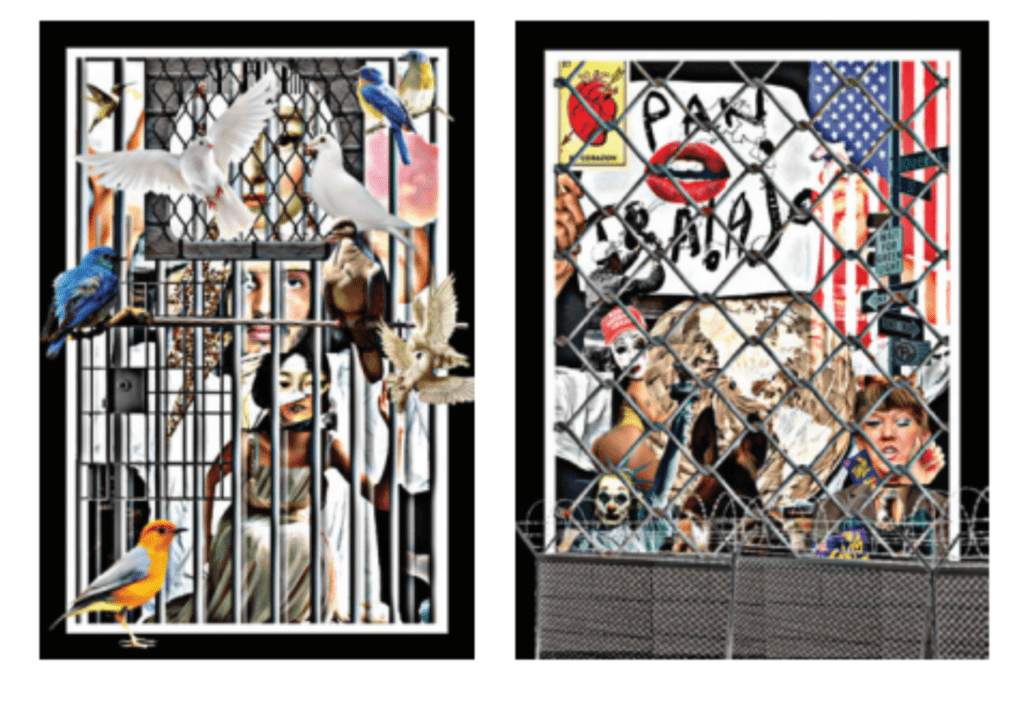
Each project is designed specifically for the virtual gallery we created, and also exists in the world as the creative expression of an independent artist attempting to survive the pandemic. In the Lab, the barriers we faced and the boundaries we crossed became part of work. The stories embedded in the virtual gallery reflect the powerful lived experiences of the participants at this unique moment in time.
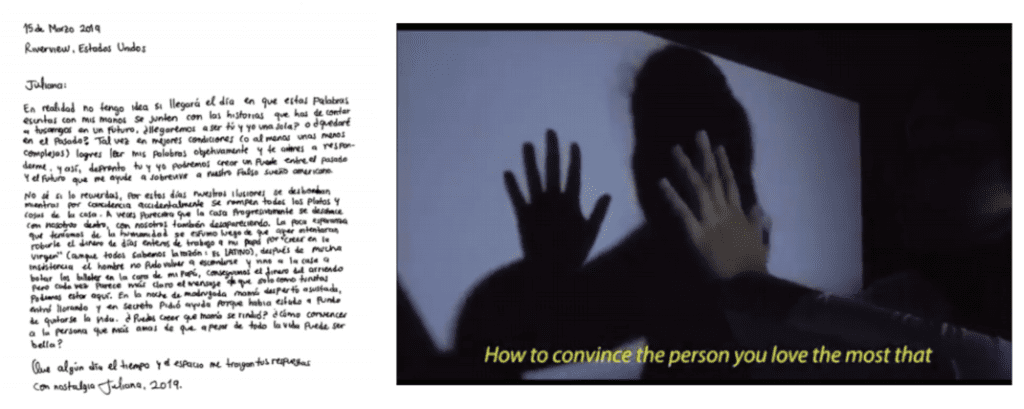
Four themes emerged from weeks of discussion that the artists chose to organize their work in the galleries: Fragments, Refuge, Reconfiguration of Identity, and Movement/Stillness. The projects included powerful stories of survival using photography, 3D modeling, poetry, single channel video, music, collage, augmented reality, and documentary.
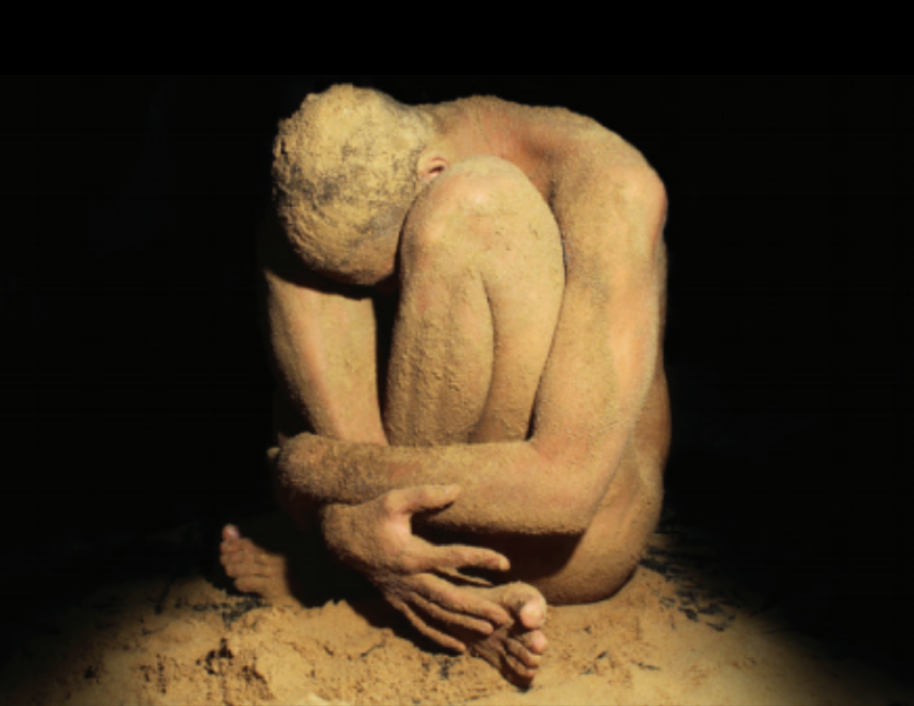
At first, the artists were hesitant to draw on their own lives for inspiration; they had wanted to use the opportunity of American Arts Incubator to work with communities at the border — to amplify their stories and raise awareness of a human rights crisis that was disappearing in the crush of coverage of the pandemic. Through the work of the Lab, the artists bravely centered their own life experiences instead and found their voices in a single phrase: we are all Migrants.

As we reimagine what our global future will look like through this darkness, I am grateful for the time I got to spend with this incredible community of artists who showed up online together for a month, hours at a time, and worked on projects alone in their homes, through quarantine, rolling blackouts, curfews, and extraordinary heat. We are all looking forward to the time when we can move the work from the virtual galleries into the streets, and into the world. Explore the virtual museum here.

I was really looking forward to spending time in Kyiv, Ukraine this past April, but my plans were thrown for a loop by the COVID-19 pandemic. With great assistance from ZERO1, I pivoted in the short space of two weeks to a fully online experience. It was also fortunate that my incubator topic was art and artificial intelligence, which meant it could be conducted mostly through digital means.
Still, that meant that I would be holding the workshop in two languages, sometimes with a professional interpreter, and sometimes not, across a seven-hour time difference.

After giving my artist talk in conjunction with Bryan Furman from the Cultural Affairs Office at the U.S. Embassy in Kyiv, I spent one session entirely online getting to know my two dozen or so Ukrainian artists, scattered throughout the country in strict lockdown inside their homes.
My on-the-ground host collaborator in Kyiv was IZOLYATSIA, Platform For Cultural Initiatives, originally based in Donetsk. I was assisted by Mykhailo Glubokyi (Misha) and Oleksandra Khalepa (Sasha).
The selected artists for the incubator were VJs, visual artists, graphic designers, programmers, engineers, musicians, sound designers, and individuals adept at working in virtual reality. Save for one participant though, no one had fully worked with machine learning before, which is the fundamental aspect of artificial intelligence.
Over the course of three days, I showcased some of the fundamentals of machine learning through art via Zoom sessions. At the same time participants were engaging in the lectures, they began posting their ideas for team projects asynchronously in Slack.
At the end of the three days, we met online and went over every artist's project idea until settling on four themes: 'Conspirology,' Environmental and Moral Responsibility, Isolation and Connectedness, and Mudra — a translation tool for Ukrainian sign language.
For the next two weeks, we dove into into accelerated development. I met with each team in Zoom from my house in New York City, as the participants were scattered throughout Ukraine.

We had only one day of presentation rehearsal to show the final works-in-process to an international panel of AI and art experts for feedback: Arif Khan of Alethea.ai, Misha Libman of Snark Art, Gene Kogan of Abraham.ai, and Vanessa Chang, a well-known San Francisco based curator.
What really surprised me was the relative ease and speed at which the artists, who had not known one another previously, were able to adapt to forming collaborative teams that used accelerated development tools. They were able to develop coherent and plausible proof-of-concept designs.
We have now concluded the initial phase of the exchange, but some of us hope to continue by forming a media arts alliance between the Baltics and Ukraine. We have a meeting scheduled for early June, and I am already looking forward to the results.
People in social distancing circles at San Francisco's Dolores Park amid the coronavirus outbreak on June 9, 2020. Photo by Lynn Friedman is licensed under CC BY-NC-ND 2.0.
The recent global pandemic has disrupted all of our lives, while highlighting a myriad of “wicked problems” facing cities. In just a matter of months, cities look and feel different. For many, we are looking at them out our window or within the small perimeter in our neighborhood. The isolation during shelter-in-place has shed light on the importance of community and public space in all of our lives.
This is a time for collective resilience.
As I will not be traveling to Peru physically, I’ve been working on adapting the exchange to a remote platform that utilizes technology for collaborative engagement through virtual and augmented reality environments. It has been challenging to re-envision a program focused on the social challenge of urban development in public space during a time of quarantines and web-based communication. However, I am optimistic about the potential for reframing these challenges as opportunities for creative exploration with the American Arts Incubator participant cohort in Lima.
During the past few months, I have been reflecting on the implications of the pandemic on the way cities are used and how they are designed. In a way, the pandemic affords us time to contemplate the present conditions and envision a better future for our cities. I’m interested in how art + technology can be leveraged to inspire collective optimism and enable participatory urbanism.
In my own creative practice, I have explored ways to contextualize and make visible the past, present, and potential futures of cities. This often involves mapping to visualize a geo-spatial and layered place narrative. I look forward to learning more about Lima from the selected group of interdisciplinary artists through their personal psycho-geography of the city and speculative vision of what the city could be. If we traveled to Lima in the year 2100, what might we write back about how the city and world has changed?
In recent years, I’ve been especially interested in interactive and participatory artwork that actively engages the audience in a process of discovery and agency in creating collaborative visions of adaptive urbanism. As we focus on Lima’s public space as a collectively owned democratized canvas, I am excited about the discussion, creative projects, and community that will come out of it. In my role as Lead Artist and facilitator, my goal is to help amplify the creative voices of the local participant artists within their communities and abroad.